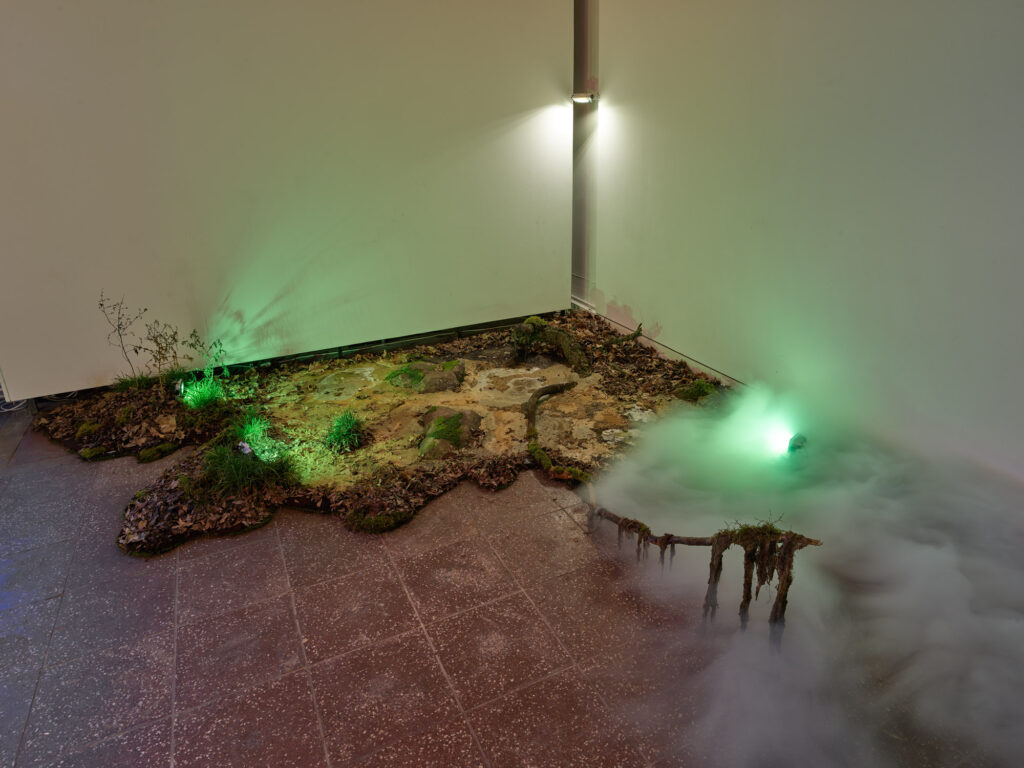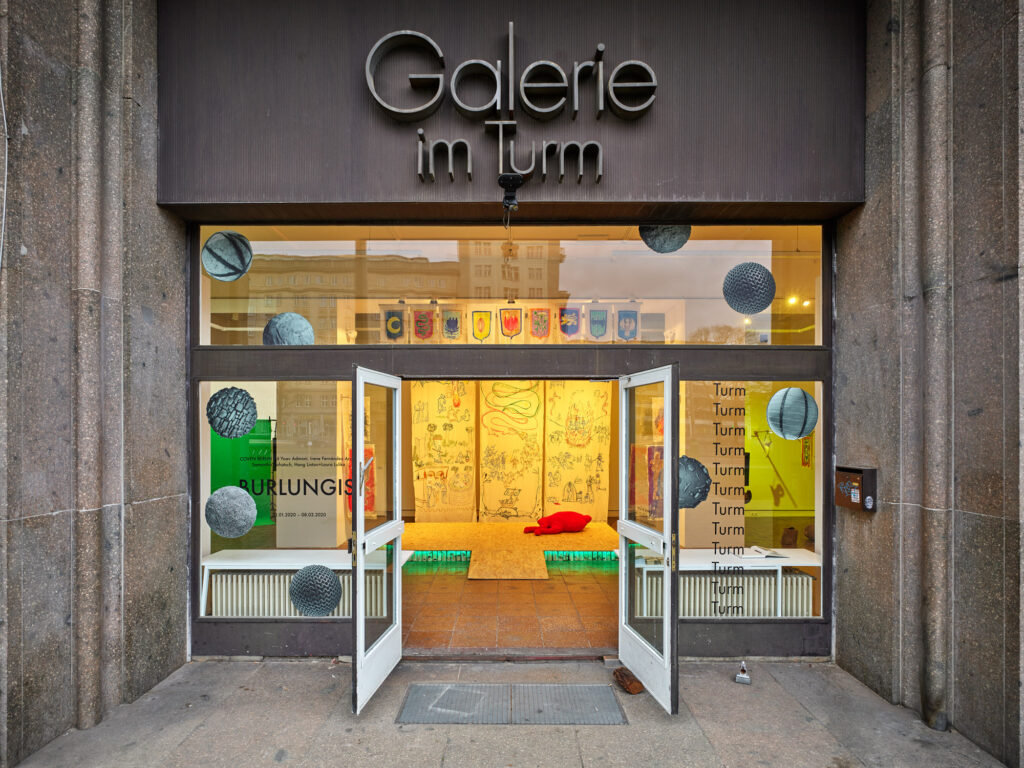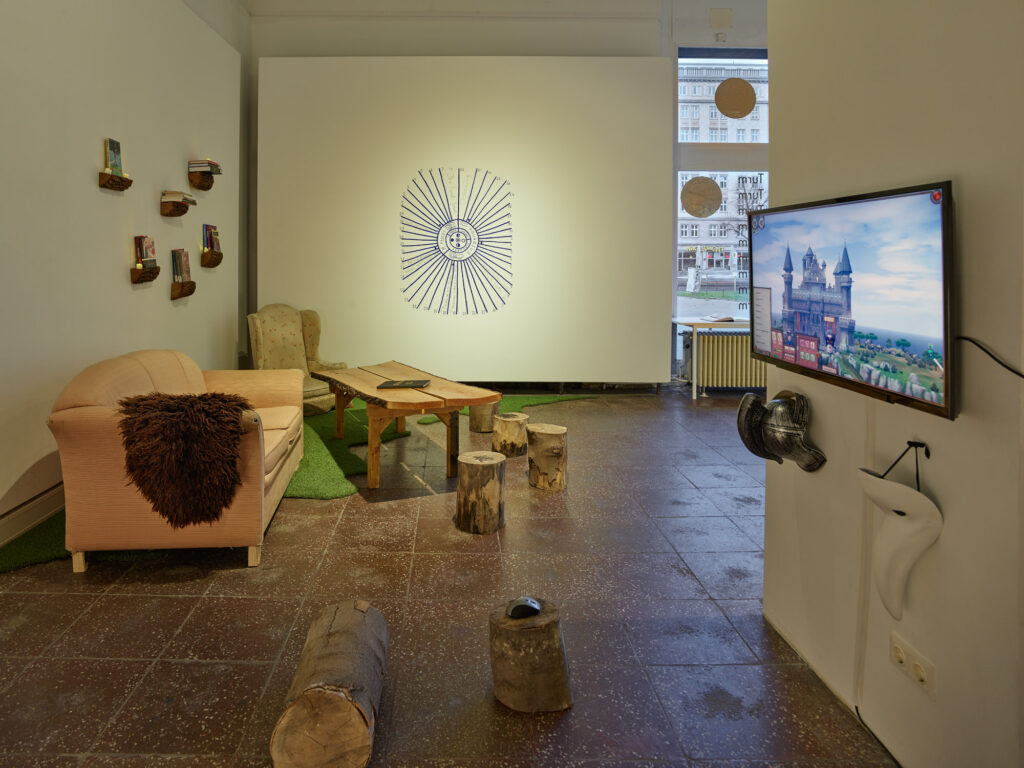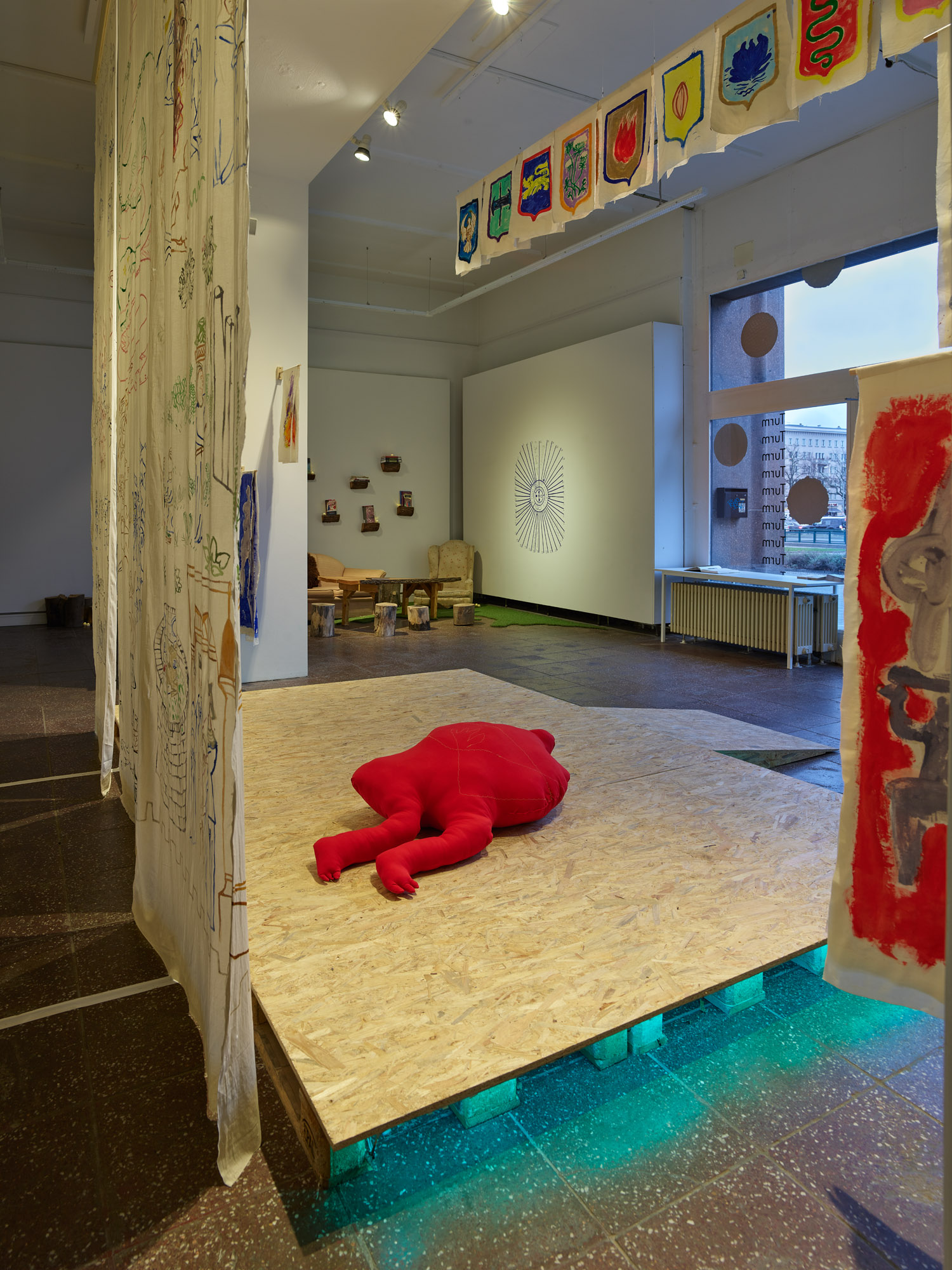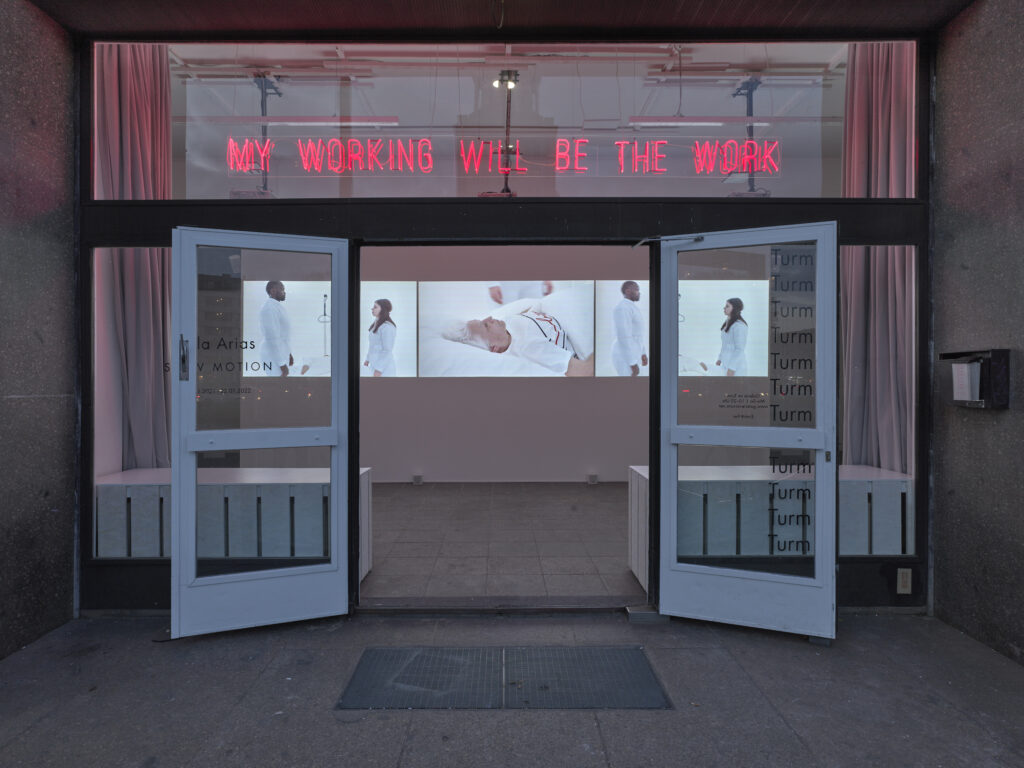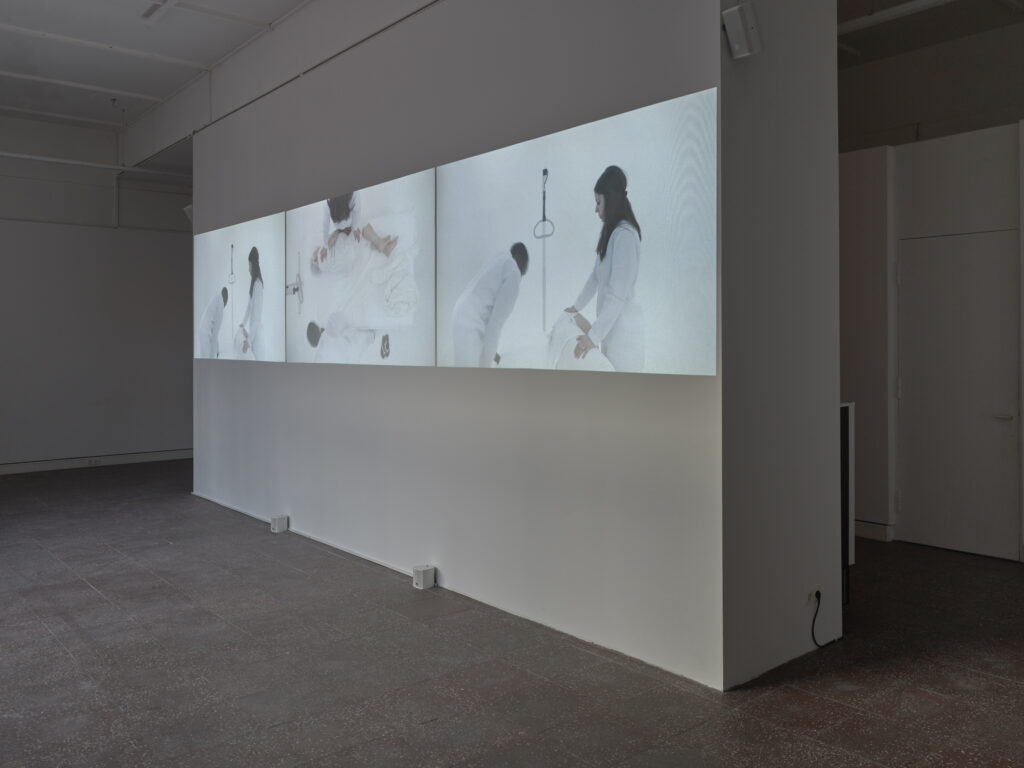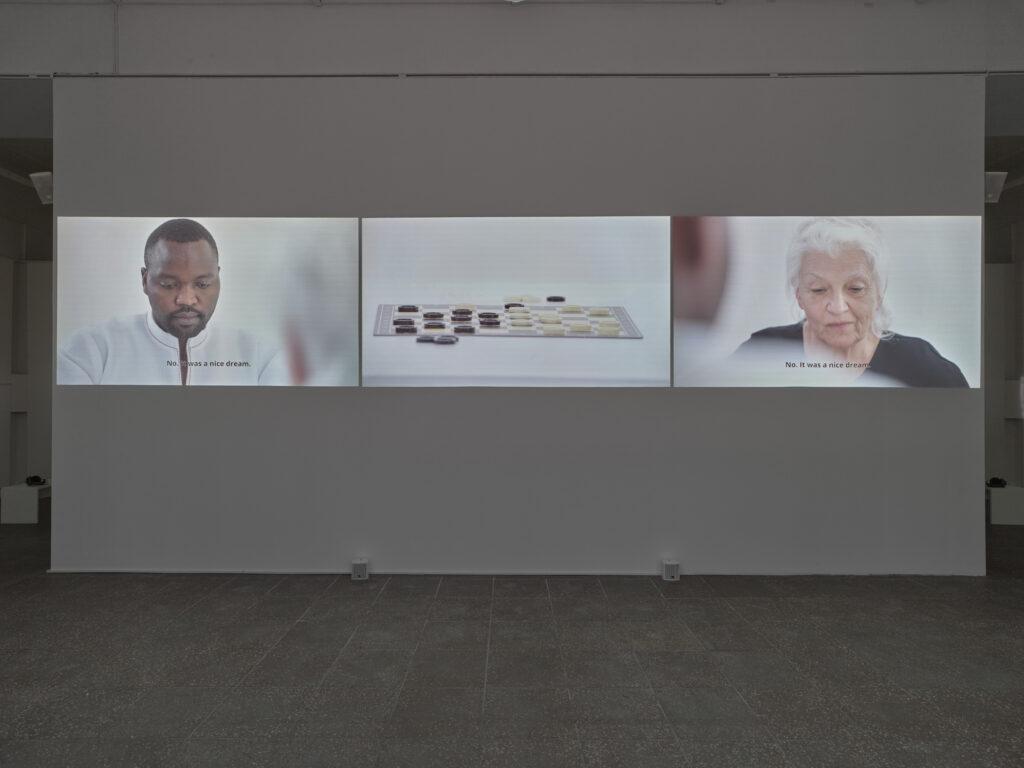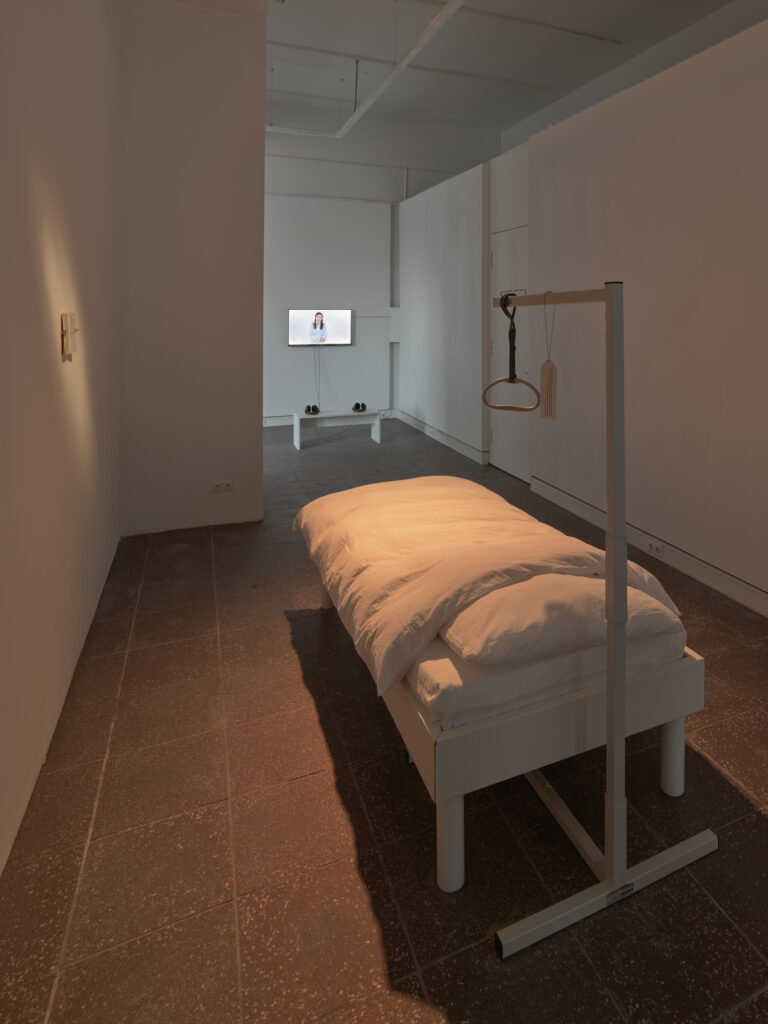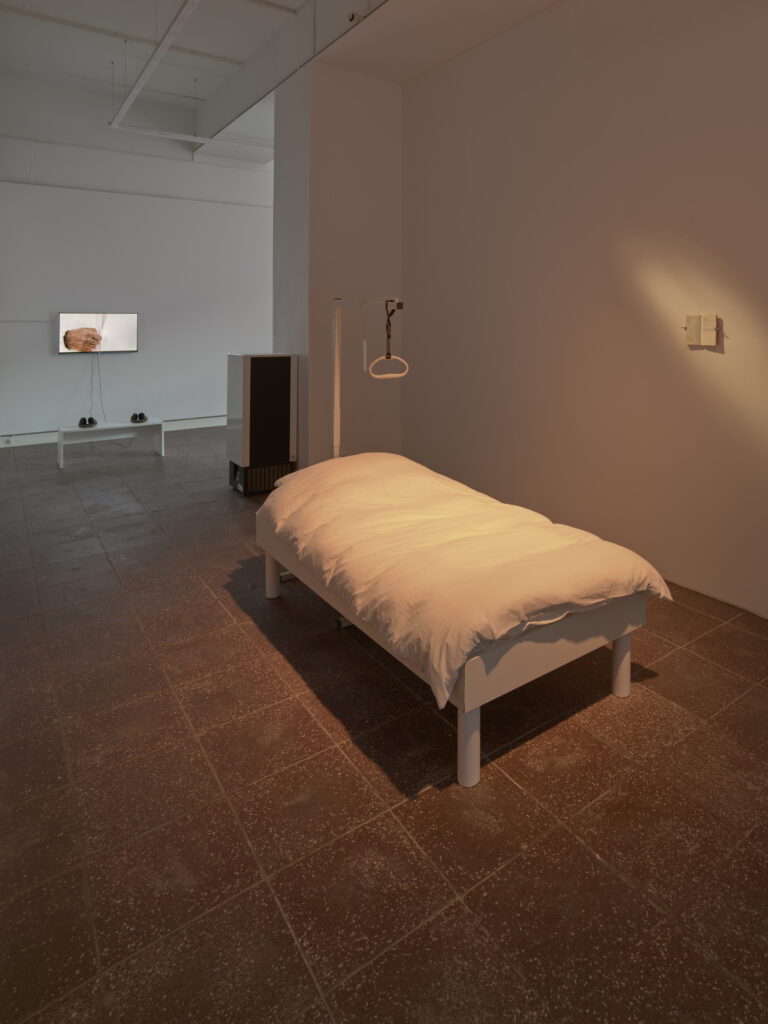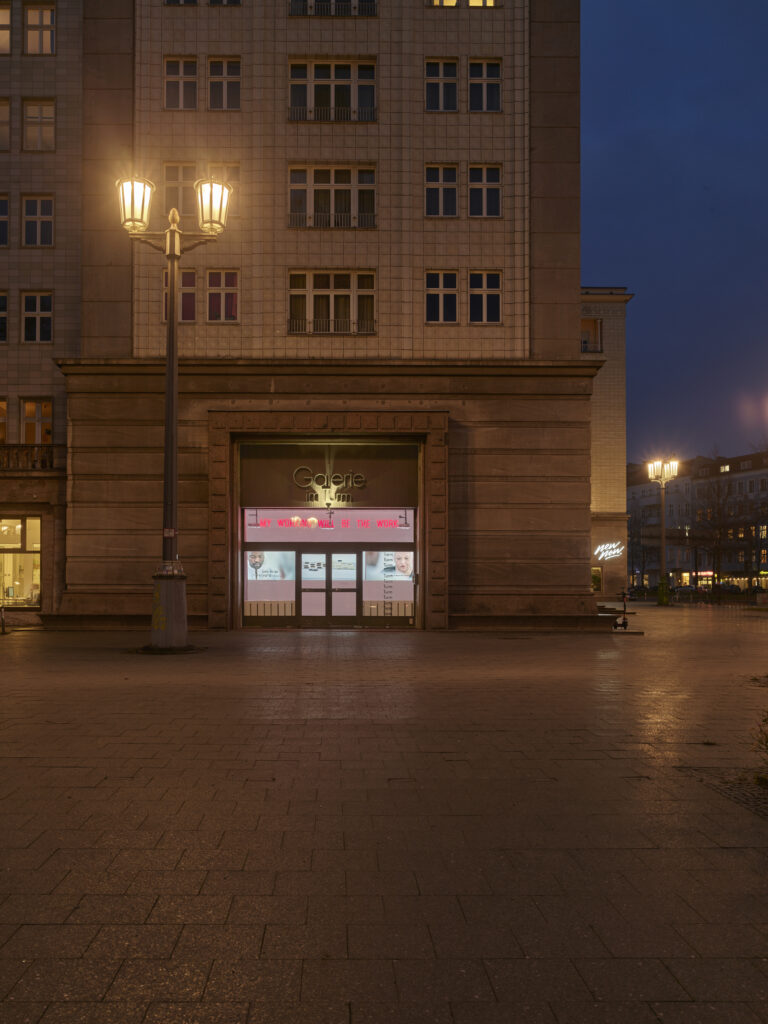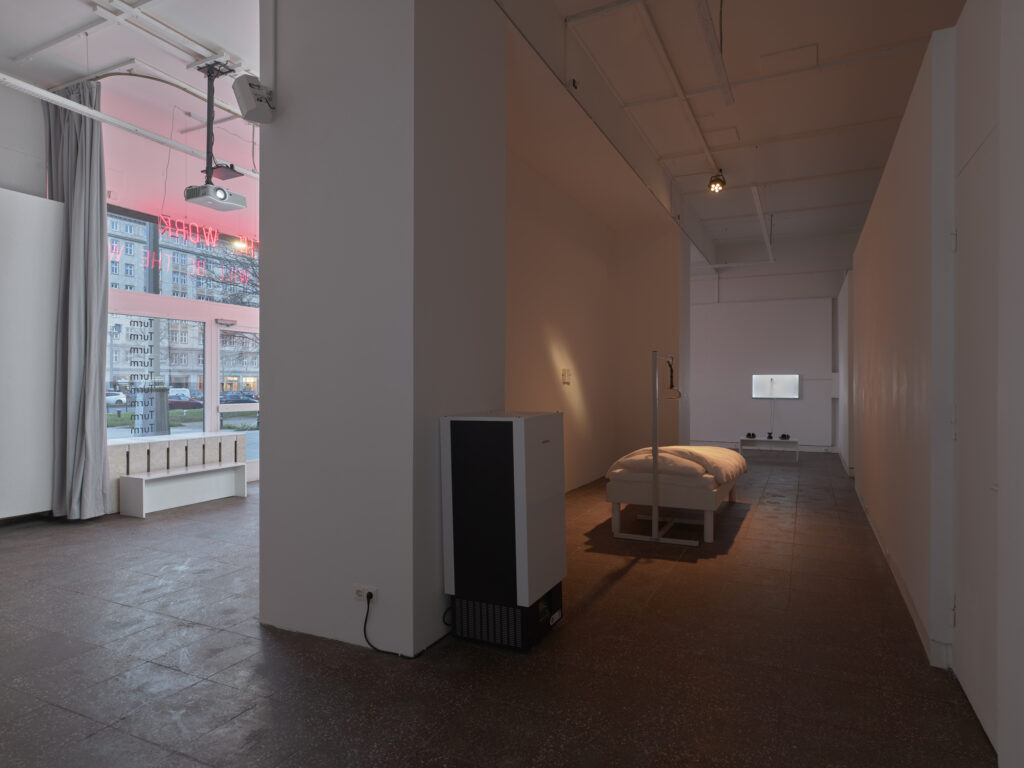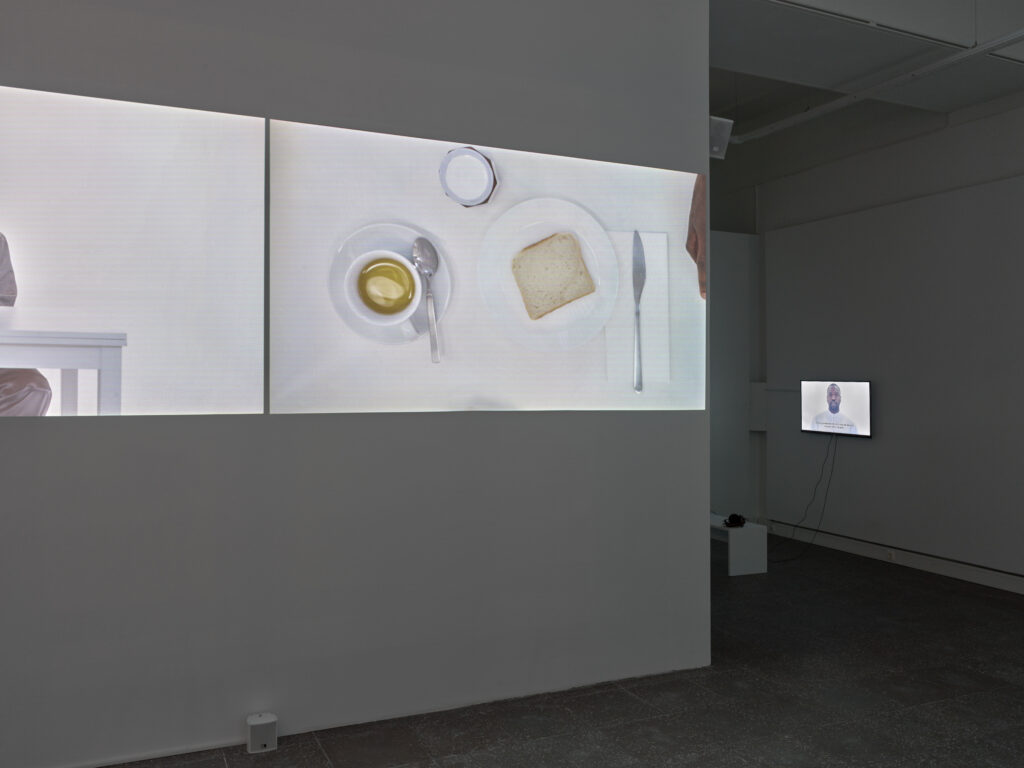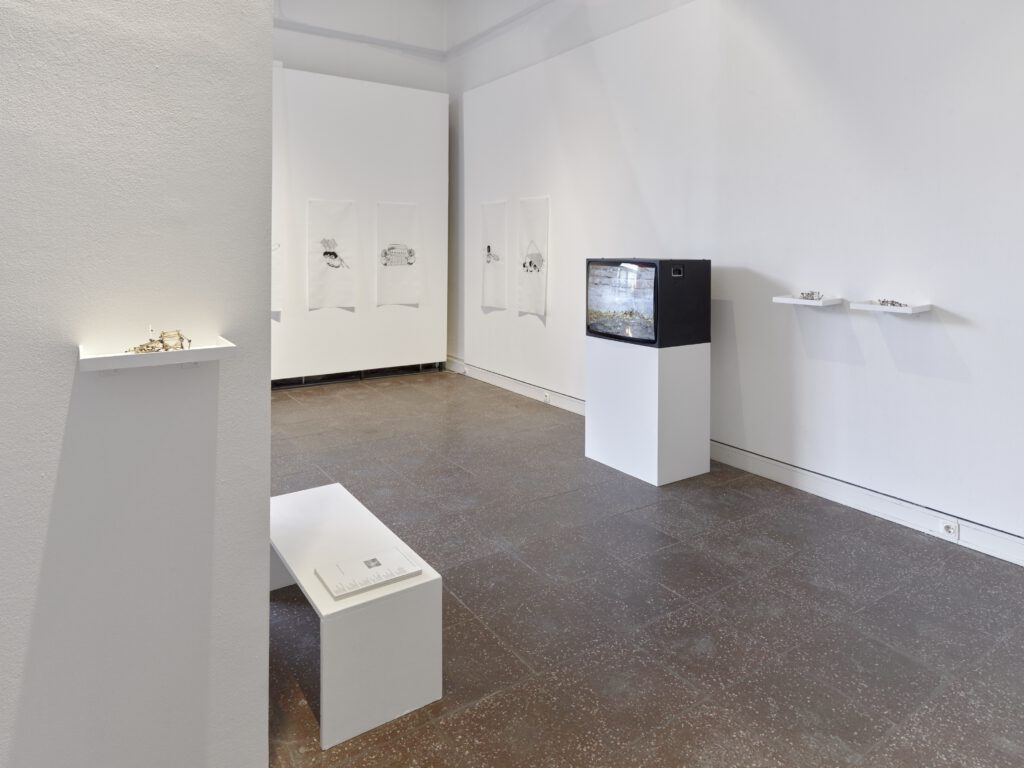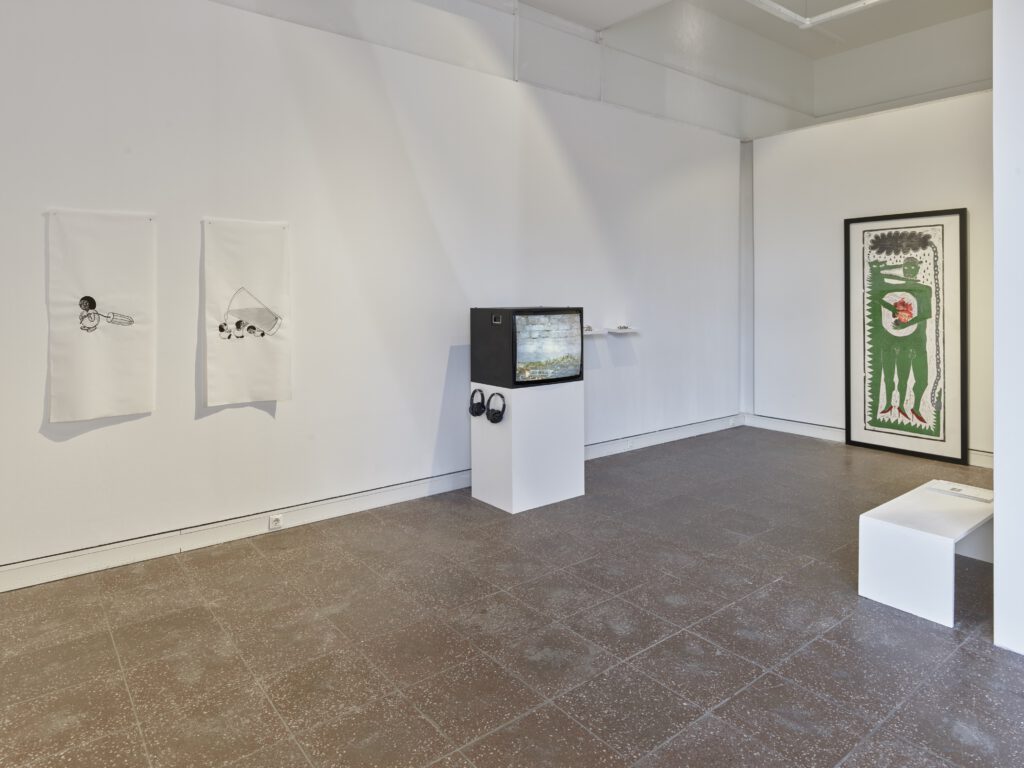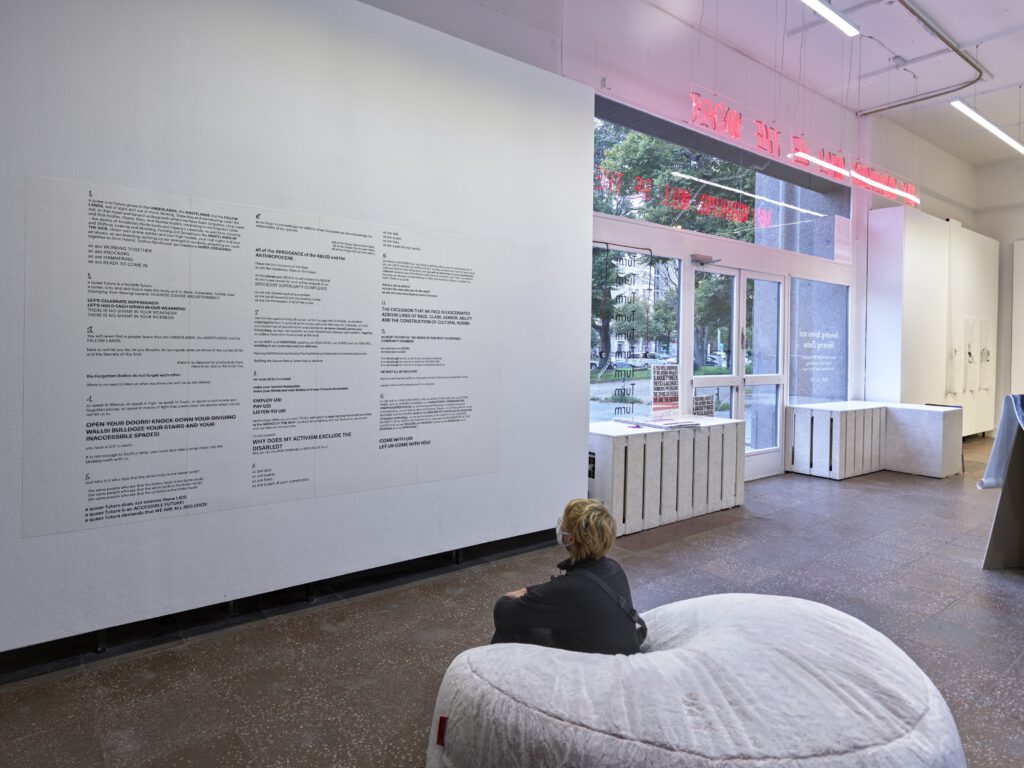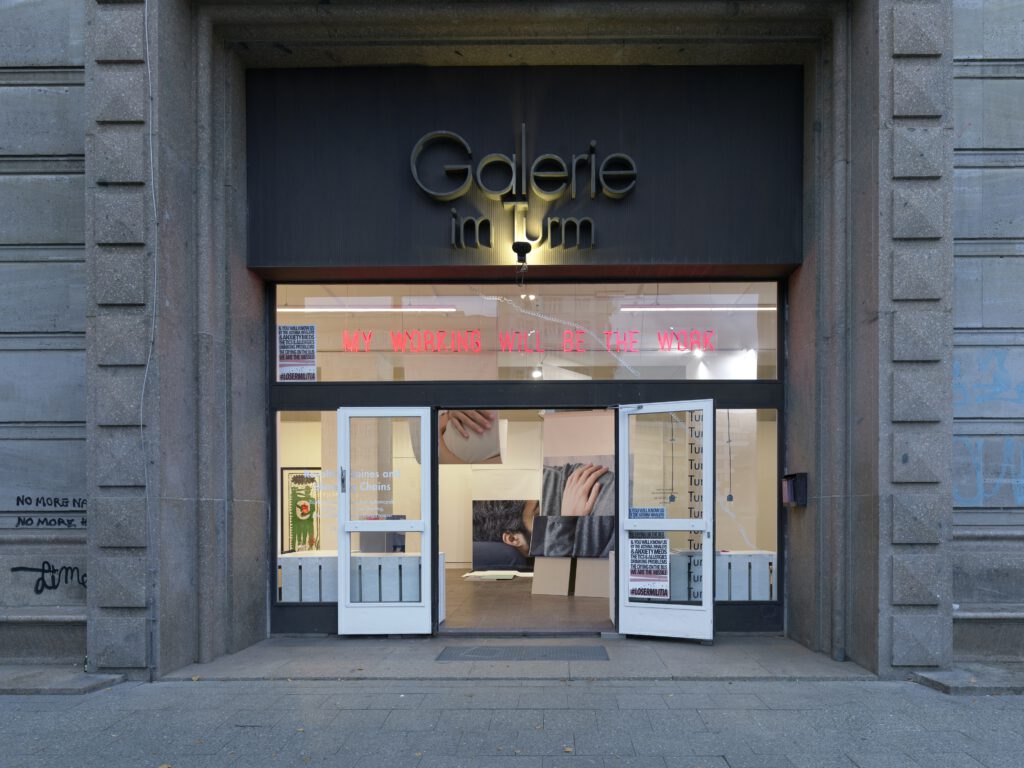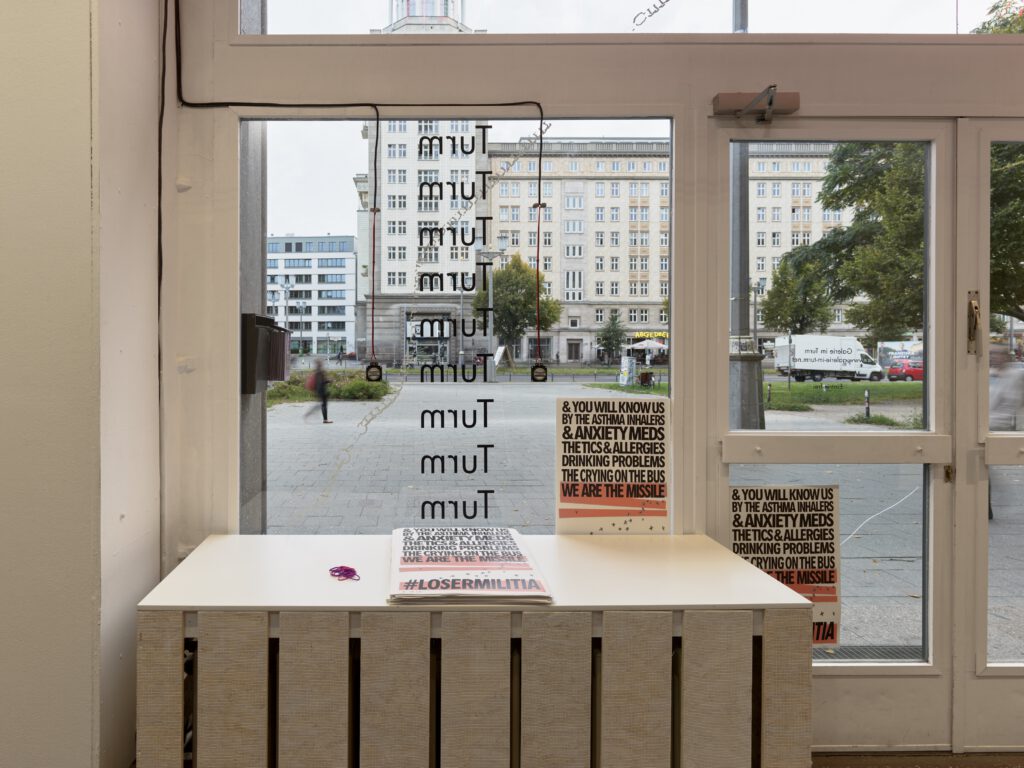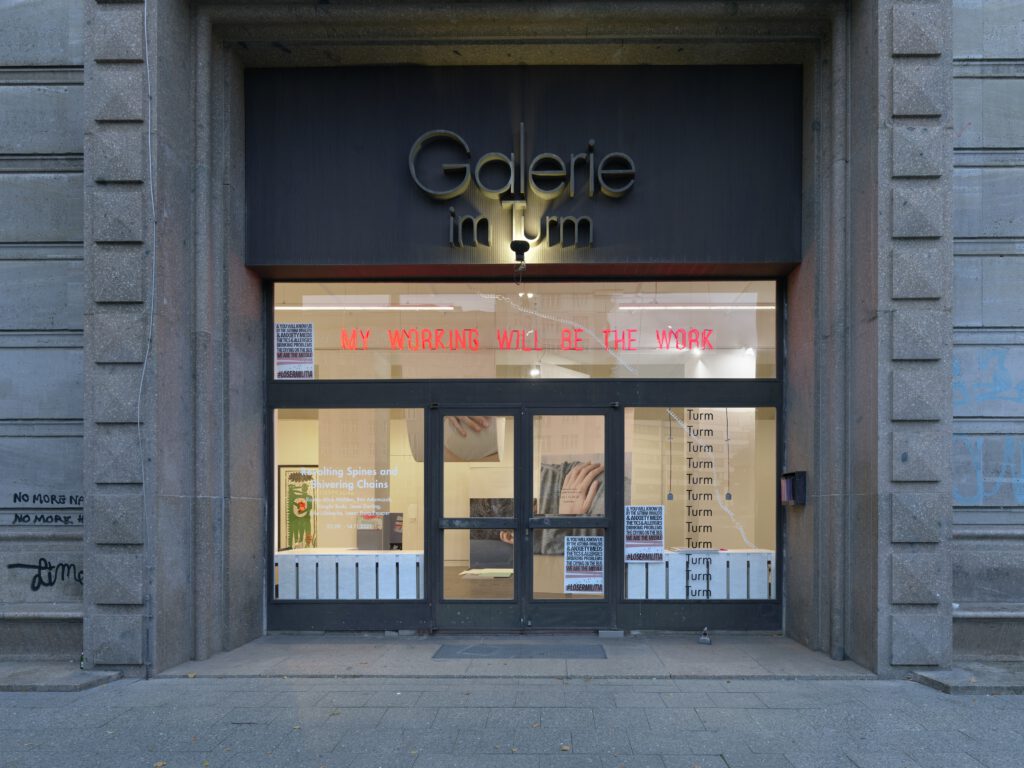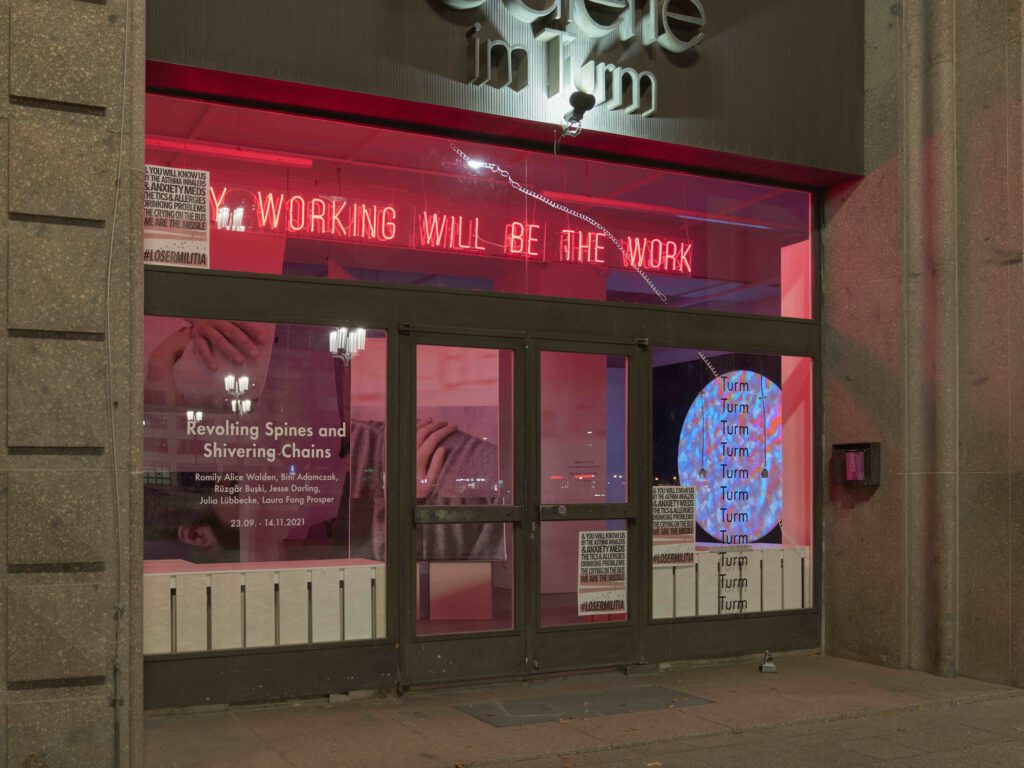Turn Illness into a Weapon – Artistic Perspectives Within Health Movements
Anguezomo Mba Bikoro, The Chronic Iconic (Jessica Cummin), Chloe Pascal Crawford, Criptonite (Edwin Ramirez & Nina Mühlemann), Miriam Döring, Tomás Espinosa, Eva Egermann & Cordula Thym, Lotti Fellner-Wyler, Feministische Gesundheitsrecherchegruppe, Cornelia Herfurtner, Kallia Kefala, Magda Korsinsky, Julia Lübbecke, MELT (Ren Loren Britton & Iz Paehr), Silvi Naçi, Sophie Utikal, RA Walden
Kunstraum Kreuzberg/Bethanien
01.06. – 18.08.2024
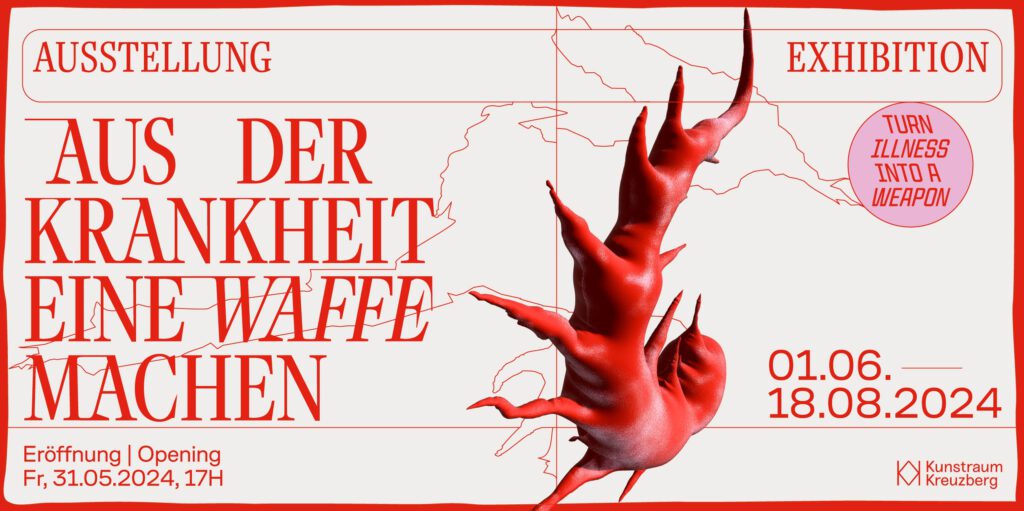
Radio Interview, Kompressor Deutschlandfunk mit Massimo Maio, Redaktion Jule Hoffmann
Article Kunst und Krankheit: Fenchel reinigt die Augen in taz. die tageszeitung by Beate Scheder
Interview Ableismus tötet noch immer – über Kunst und das Crip Movement in Reversed Magazine by Mina Schmidt
Reacting to the healthcare system’s discriminatory structures, in 1972, the Sozialistische Patient*innenkollektiv1 (Socialist Patients‘ Collective) called to weaponise their illness. The group aimed not to portray illness as something individual that must be overcome alone, but to show its complex connections with social neglect and structural inequalities. Relatedly, this exhibition draws attention to the structural and intersectional disadvantages faced by disabled, chronically ill, and/or neurodivergent people in a late-capitalist, ableist system. How to turn illness into a weapon?
The group exhibition Turn Illness into a Weapon – Artistic perspectives within healthcare movements2 takes its starting-point from the grassroots healthcare struggles around the former Diakonissen-Krankenhaus (welfare hospital) Bethanien in 1970s Berlin. When it became clear that the abandoned building was to be transformed into artists‘ studios, the initiative Kampfkomitee Bethanien, among others, demanded to use the space as a children’s polyclinic.
In the exhibition, 17 artistic positions are brought into dialogue with the site where these specific political struggles played out. The artists criticise present-day conditions in art and healthcare policy, and point towards alternatives.
Because the time is now and the future is crip.3
The anti-ableist constellations of MELT (Ren Loren Britton & Iz Paehr) visually combine past resistance movements of disabled activists in Germany with astronomical images of stars, which are used to mark spatial and temporal dimensions. The Chronic Iconic (Jessica Cummin) is a Mad Cripfluencer who translates her educational work into banners that invoke resistance. Tomás Espinosa’s oversized pills thematise both the stigmatisation and treatment of HIV-positive people, as well as hurdles to accessible medication. In their letters to an octopus, Criptonite (Edwin Ramirez und Nina Mühlemann) tell tales of crip magic, solidarity, and sea witches with a short life expectancy. Connecting political and physical attitudes and relating them to National Socialist violent body ideals still prevailing today, Julia Lübbecke expands her subjective research on feminist self-help. Lotti Fellner-Wyler’s paintings reflect her life, including her artistic approach to dealing with multiple hospitalisations. Silvi Naçi visualises the pain that accompanies them during the production of their artworks. The fatigue caused by the demands of a performance-driven society is explored in Kallia Kefala’s installation work. RA Walden views chronic illness as a political issue that needs to be taken out of isolated spaces, and discussed publicly. The Feminist Health Research Group, which has long researched past and current feminist and health policy movements and their links to radical therapy, anti-psychiatry and queer self-care, uses artistic means to work through its materials. Experiences of intimacy, connection, and individual approaches to healing are a part of Sophie Utikal’s walk-through textile installation. Anguezomo Mba Bikoro engages in restorative justice practices through rituals to provide Black women, notably affected by chronic illness from domestic violence, with safe access to discrimination-sensitive medicine and mental health support, while critically reflecting on colonial somatic body theory. By juxtaposing historically informed concepts of warmth with somatic knowledge, Miriam Döring investigates the ambiguity and intimacy of heat, both as a therapeutic method and as a harmful element. Magda Korsinsky offers insight into connections between ageing, disability, and sexuality. A crip-queer-feminist video work from Eva Egermann & Cordula Thyms invites viewers into a punky world of plural accessibilities.
The struggle for Bethanien, the ideas of the Sozialistische Patient*innenkollektiv, and the transformation of illness into a weapon are contextualised through archival material and the accompanying programme of events. Cornelia Herfurtner approaches passive arming as a resistant practice of self-protection during protests in public spaces and asks what we need to strengthen ourselves. Chloe Pascal Crawford examines connections between weapons and disability, drawing attention to the violent laws structuring everyday life in Berlin.
The exhibition and accompanying programme are dedicated to political struggle, to artistic practices with sustainable and lasting effects, and to historic, current, and future anti-ableist visions.
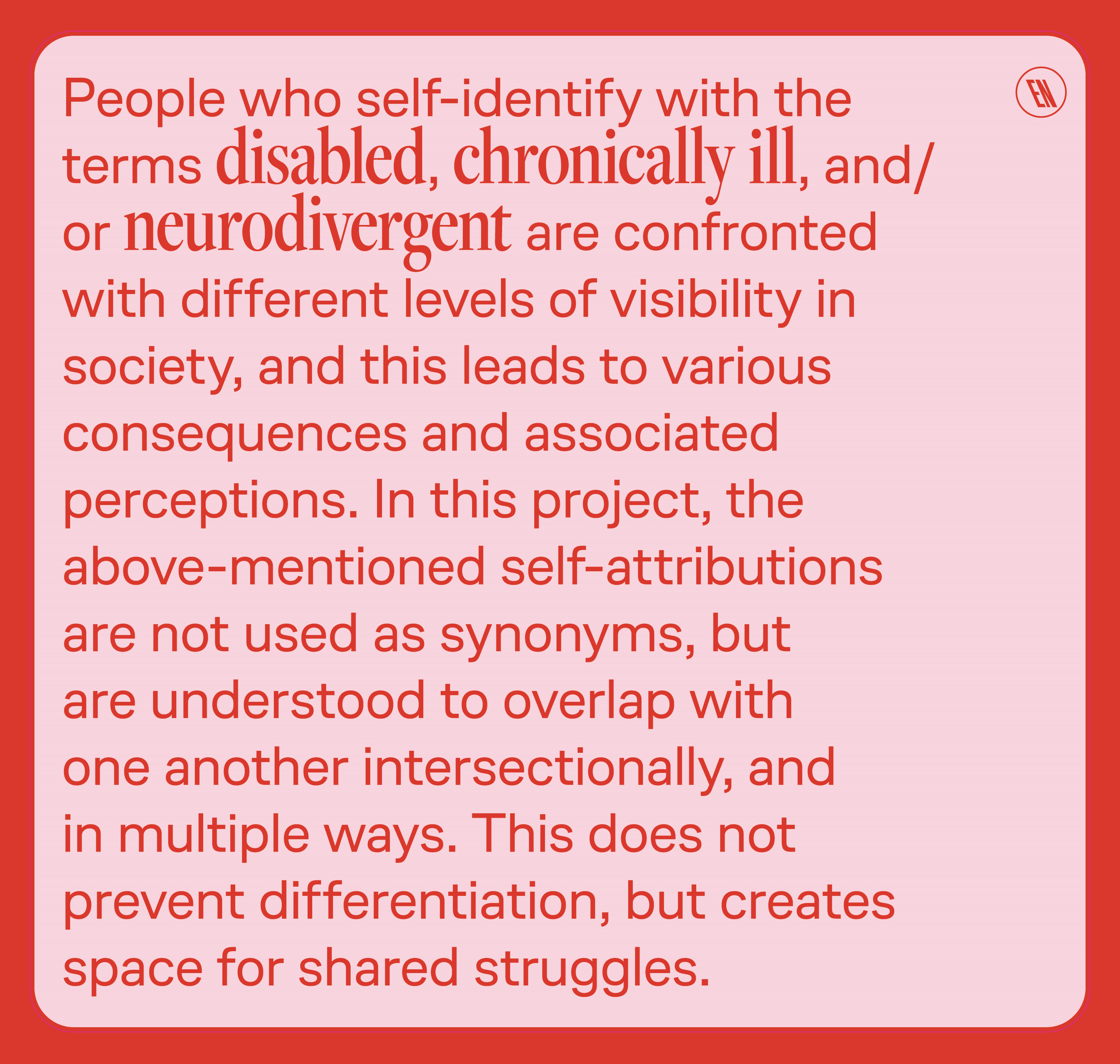
1 German spelling adapted to present-day gender-neutral norm.
2 This title refers to the magazine of the Sozialistische Patient*innenkollektiv, similarly titled SPK – Aus der Krankheit eine Waffe machen – Eine Agitationsschrift, (“SPK – Weaponise Your Illness – A Magazine for the Movement”), Heidelberg University.
3 Eva Egermann, Editorial of Crip Magazine #2, Vienna 2017.
Curated by
Linnéa Meiners
Curatorial assistance
Gianna Ehrke
Consultation for barrier-free exhibition design
Berlinklusion – network for accessibility in art and culture
Jovana Komnenic & Kirstin Broussard
Graphic design
kadi | studiokwi
Plain language translations
Helen-Sophie Mayr
English translations
Sonja Hornung, Eve Richens
Director Kunstraum Kreuzberg/Bethanien
Stéphane Bauer
Programme Coordination
Sofía Pfister
Production
Kristoffer Holmelund
Project assistance
Melina Gentner
Dani Hasrouni
Johanna Janßen
Marlene Risse
ACUD Galerie
Linnéa Meiners has been the artistic director of ACUD Galerie from April 2023 until July 2024. ACUD Galerie is the non-commercial exhibition space of ACUD MACHT NEU. Additionally to the own gallery programm, curators and artists are invited to conceive exhibition series and single exhibitions, often in conjunction with performative and discursive formats in the other spaces of the house.
Most of the exhibitions focus on the possibility of new forms of social cooperation and alternative world views in connection to discourses on post-nationalism, decolonisation, post-capitalism, activism, feminism, queerness, embodied practices and multiperspectivity. The exhibition program never stands in isolation, but is accompanied by a participatory framework programm that enhances exchange and discourse.
ACUD Galerie is funded by the Basisförderung der Senatsverwaltung für Kultur und Gesellschaftlichen Zusammenhalt.
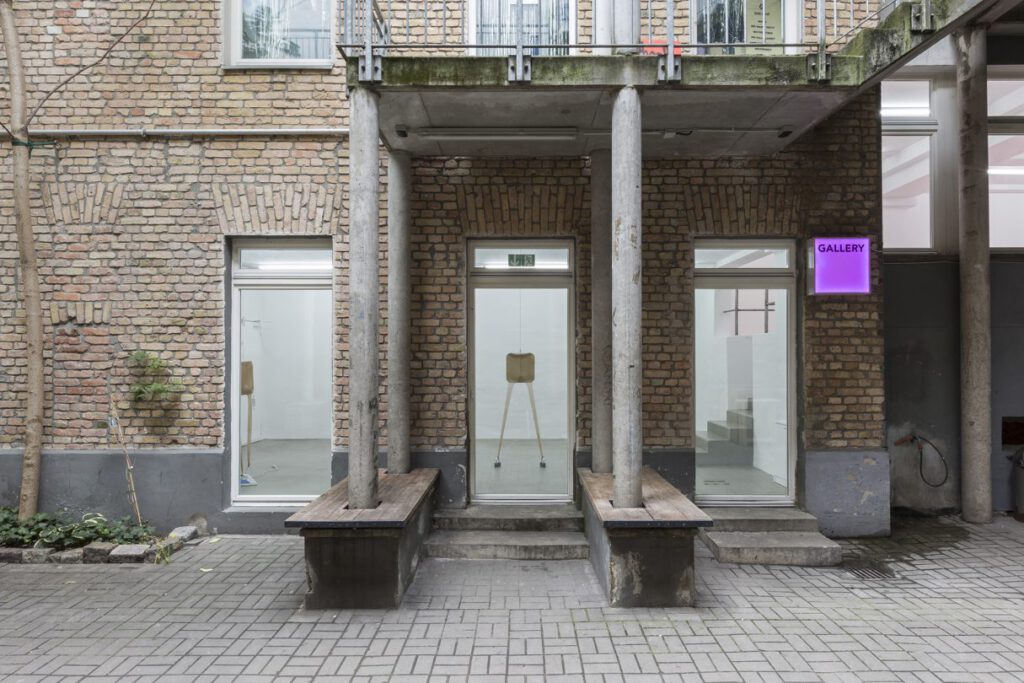
Echoing Futures. On Practices of Radical Imagination
Exhibition series with accompanying programme at ACUD Galerie
22 March 2024 until 12 January 2025
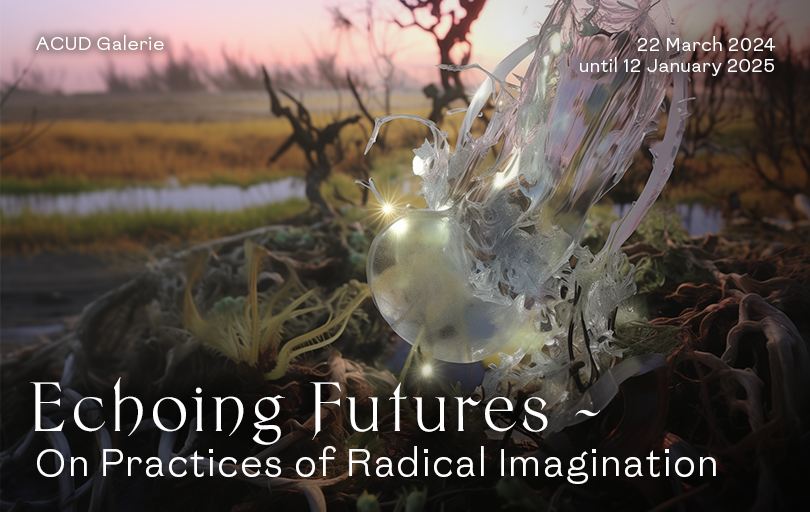
“I dwell on hope, because I wish to think about futurity; and hope, I argue, is the emotional modality that permits us to access futurity, par excellence.”
José Esteban Muñoz
In current times shaped by late capitalist crises, pandemics, wars and climate catastrophe overshadow the future. It is challenging not to succumb to these circumstances, constraints and inequalities – let alone imagine progressive, sustainable and socially-equal futures together, hope for them and participate in their materialisation.
Echoing Futures – On practices of radical imagination includes six exhibitions and an accompanying programme. The exhibition series at ACUD Galerie intends to create space for learning, practising, hoping and entering into a trustful dialogue about possible futures – building on contemporary and past realities that cannot be forgotten nor denied. The series aims to meditate on radical imagination as a deeply-rooted and constantly growing vision. In order to imagine new worlds, habituated patterns must be interrupted, possibilities unearthed and experiences shared.
What happens when we unite and engage in radical imagination? Is it possible to accept our differences and to begin a dialogue about possible courses of action and different positions? How can we not solely strive for light and order, but also explore darkness and embrace chaos, disorder and emptiness? How can we share knowledge considerately in virtual space? How can virtual space allow us to remember and communicate with each other as equals? How do we raise our voices and let them swell in order to fight for visibility? What possible worlds accept us as we are? What if healing is no longer a necessity? What if mythological narratives are read and retold again in queer ways?
Installative, visual, virtual, and performative works will be made available in German, English and German sign language. World-building games will let visitors consciously delve into the exhibitions, create their own worlds and playfully explore immersive space.
At ACUD Galerie, a time of educated hope and practised radical imagination will find its beginning. Alternative perspectives will be explored, artistic solutions developed and the participation and collaboration of different voices and experiences welcomed.
Let us imagine radical futures that are not threatening, but offer access to transformation and becoming in solidarity.
Participants
Sophia Bulgakova, Tianzhuo Chen, Magdalena Emmerig, Maja Chiara Faber, Dimitris Gketsis, Julia Grüßing, František Hanousek & Jakub Hájek, hypereikon, Konyl Sir, Chiu Laozh, Jung Min Lee, Lebendige Gebärden, ONEIRIC SPACE, Nnenna Onuoha, Lia Perjovschi, Svetlana Romanova, Sickness Affinity Group, Sondi, Natália Sýkorová, Stanislav Zábrodský and more
Team
Artistic direction: Linnéa Meiners
Curation: Alžběta Čermáková, Gabriela Matuszewska and Linnéa Meiners
Press: Franciska JC Schmitt
Production: Miriam Döring
Exhibition design: Torsten Oetken
Social Media: Gabriela Matuszewska
Artwork by hypereikon
Supported by the multi-sector funding programme of the Senate Department for Culture and Social Cohesion
Chapter 1:
There has to be smth in the room
March 22 – April 28, 2024
Opening: Thur., March 21, 2024, 6 – 10 pm
Chapter 3:
Олоҕум хараҥа суолугар уһуктар мин эрэлим сарсыҥҥы күҥҥэ – On My Life’s Dark Path My Hope for Tomorrow Appears
June 21 – July 21, 2024
Opening: Thur., June 20, 2024, 6 – 10 pm
Chapter 5:
October 18 – November 17, 2024
Opening: Thur., October 17, 2024, 6 – 10 pm
Chapter 2:
Algorithmic Monuments
May 10 – June 9, 2024
Opening: Thur., May 9, 2024, 6 – 10 pm
Chapter 4:
September 6 – October 6, 2024
Opening: Thur., September 5, 2024, 6 – 10 pm
Chapter 6:
November 29, 2024 – January 12, 2025
Opening: Thur., November 28, 2024, 6 – 10 pm
BERLIN BRITZENALE 4
Antje Majewski & Paula Oltmann, Barbara Gamper, Collective Disaster, David Horvitz, Fadi Aljabour, HakkaMoon, Julia Frankenberg, Kim Bode, Lacy Barry, MELT (Ren Loren Britton & Iz Paehr), Silvia Noronha, Xiaopeng Zhou
Urbaner Waldgarten Britz
25.08 – 27.08.2023
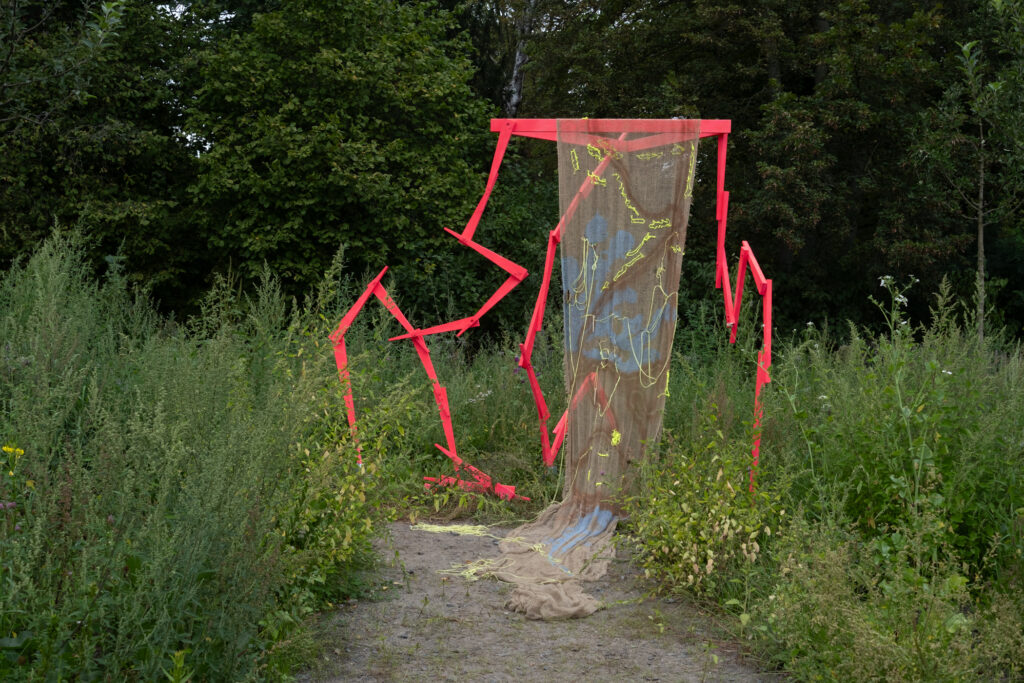
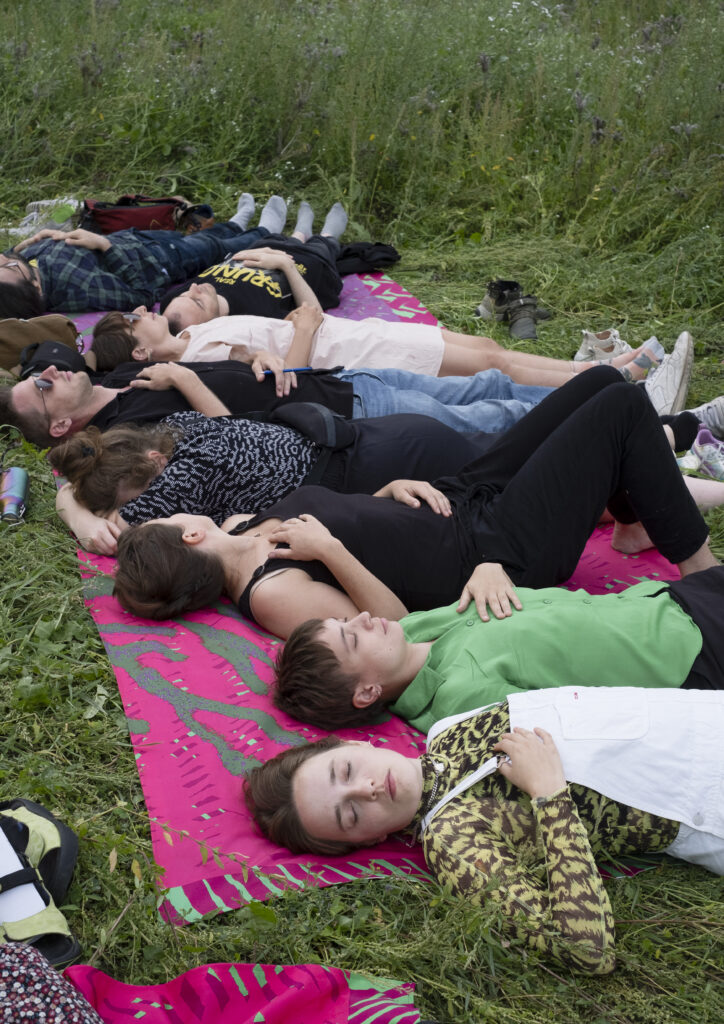
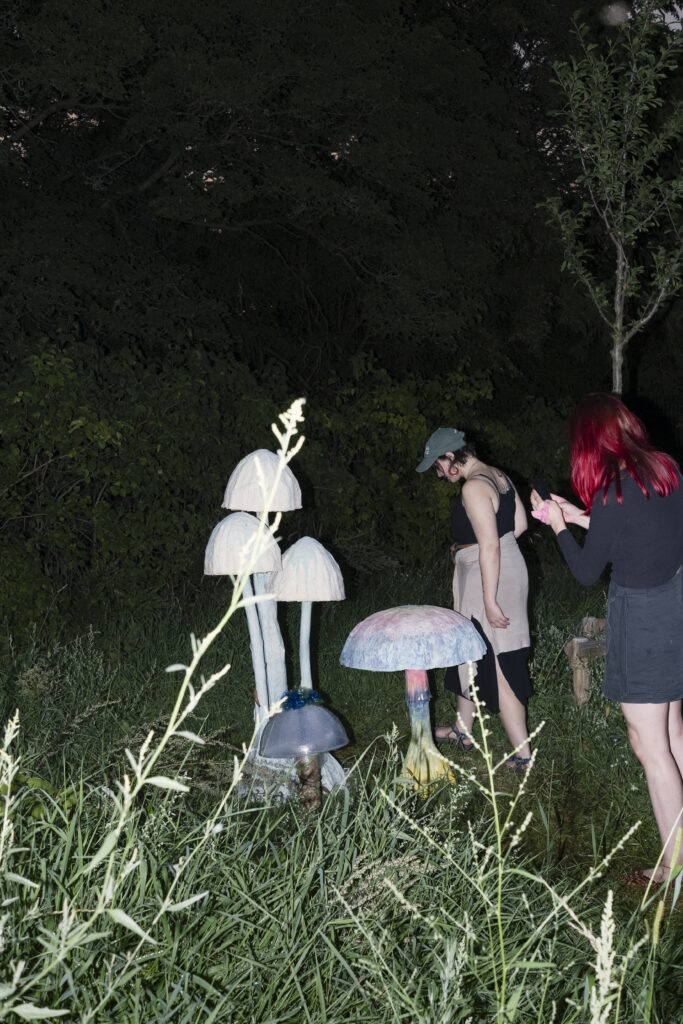
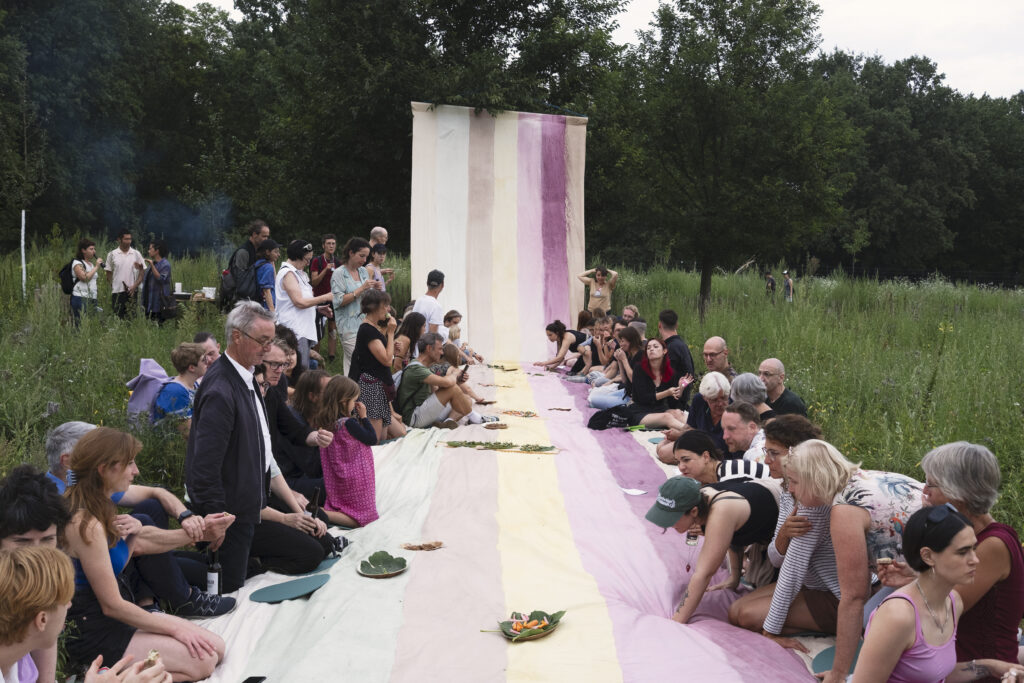
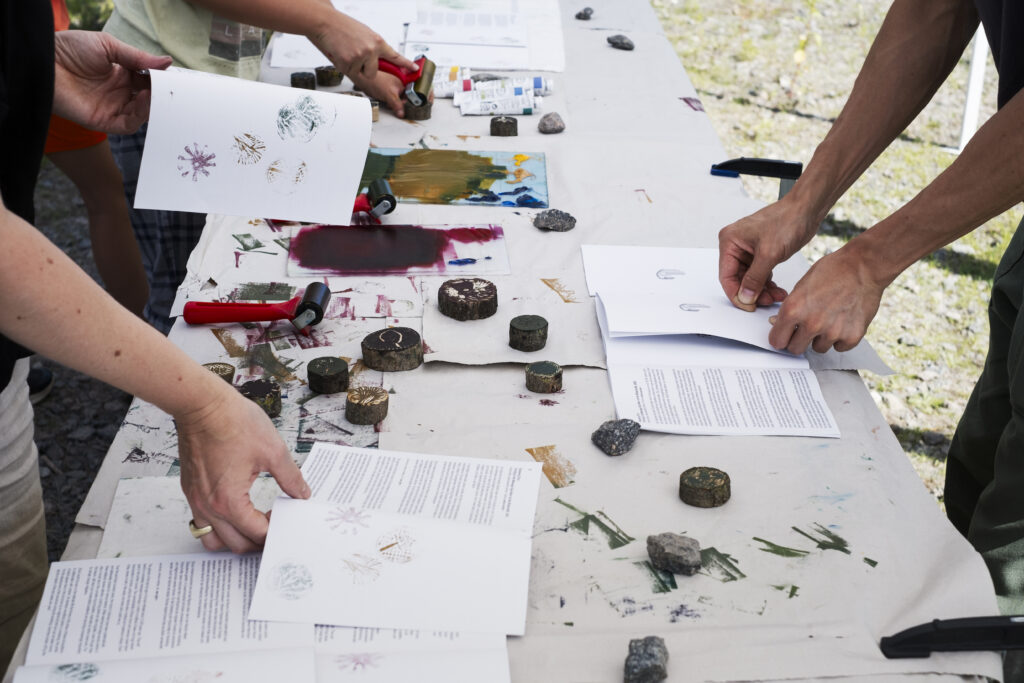
Curatorial text by Christof Zwiener and Linnéa Meiners
The BERLIN BRITZENALE has continuously evolved from the microcosm of a single lot in an allotment garden site Morgentau e.V. on Blaschkoallee since 2016. After three multifaceted, site-specific exhibitions, the BERLIN BRITZENALE is taking on the challenge of a new concept.
This year, the art festival is cooperating with a contemporary and visionary allotment garden concept: with the Urban Forest Garden Britz, an exciting location for artistic exploration has been found for the fourth BERLIN BRITZENALE. The Urban Forest Garden is currently in the process of emerging and becoming and imitates patterns and conditions found in nature and ecosystems. In the future, 60 allotment gardens and an area for communal gardening will be created here.
After the third BRITZENALE, the need came up to reflect on how an art festival can develop sustainably without striving for quantitative growth. These reflections justified the deliberate move to this location within the Neukölln district of Britz, which is exploring a novel model of gardening and thus looking to the future in a timely way.
Urban food forests consist of many layers. They are composed of fungi and roots, herbs, vegetable plants, berry bushes and shady fruit and nut trees, which are grown and harvested together on a long-term basis. The concept of the forest garden within urban gardening fulfills ecological functions such as soil protection, climate adaptation and promotion of biodiversity. The fourth BERLIN BRITZENALE observes the specific processes of the complex development of the forest garden in order to artistically understand, highlight and become a part of it.
The twelve invited artists deal with the queerfeminist potential of mycelium, ephemeral sculptures created for insects, DIY techniques of composting, sounding landscapes, dance in connection with the earth, artistic experiences of gardening and enjoyment, with icy squirts, the loud silence of bats, with the colourful, compostable extravagance of mushrooms, fictional tales of worlds in solidarity, with found materials serving as archives and myths about bogs and swamps.
In times of immense effects of human-made climate change, the fourth BERLIN BRITZENALE is taking up the challenges at this forward-looking location not to exclusively tackle the topic of gardens and gardening itself. Rather, this serious situation raises the inescapable question of the possibilities of sustainable art production. What does sustainability mean to us? For whom does it mean something quite different?
We ask ourselves these questions in many conversations, explorations and research between all participants. This opens up important and current discourses around climate justice, accessibility of art and climate projects as well as progressive visions of the future, which can be experienced here and now at the three-day BRITZENALE.
The worlds we build in this way are created on the ground of the past. Let us together find new ways in which we not only care for each other, but also encounter nonhuman life with care and empathy. We are far from having learned and invite you to envision, discuss, enjoy and explore, to think and grow together into the future in this place.
Galerie im Turm
Galerie im Turm was founded in 1965 as an exhibition venue of the Verband Bildender Künstler (sic!) der DDR (VBKD) and has been located on the ground floor of the North Tower at Frankfurter Tor, designed by Hermann Henselmann, for over 50 years. Since 1990 it has functioned as municipal gallery of the district. It shows contemporary positions of mostly Berlin-based artists.
All photos on this page are by Eric Tschernow.
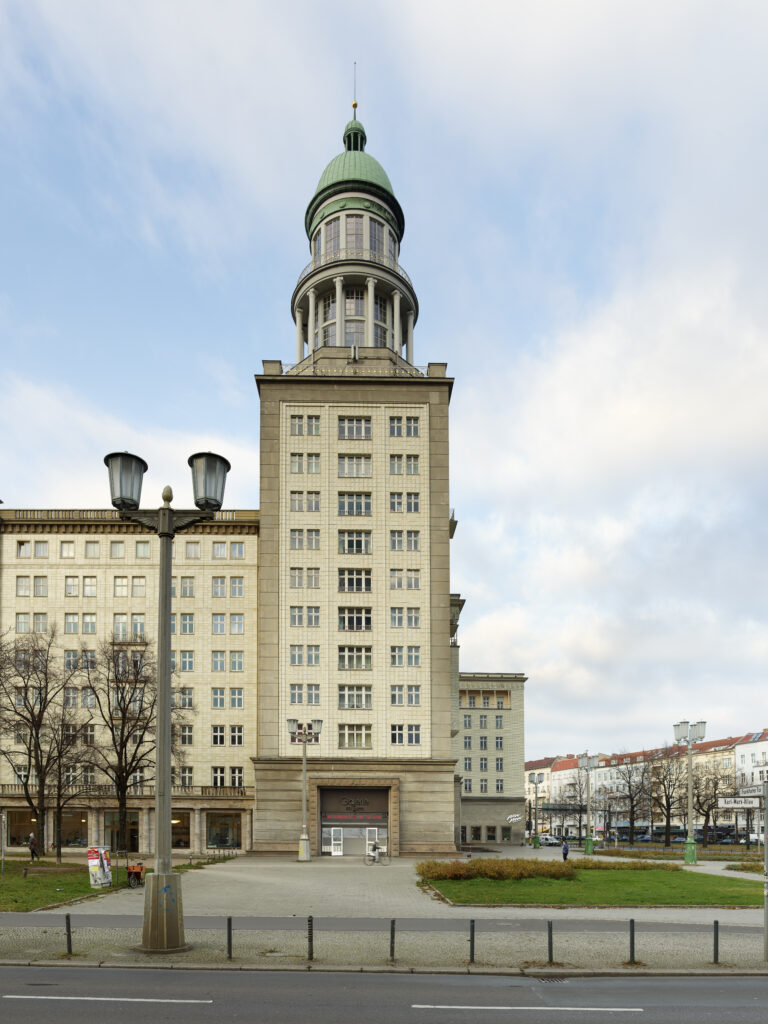
Her left year is shorter than her right
Kandis Friesen & Natalia Revko
14.7. – 25.9.2022
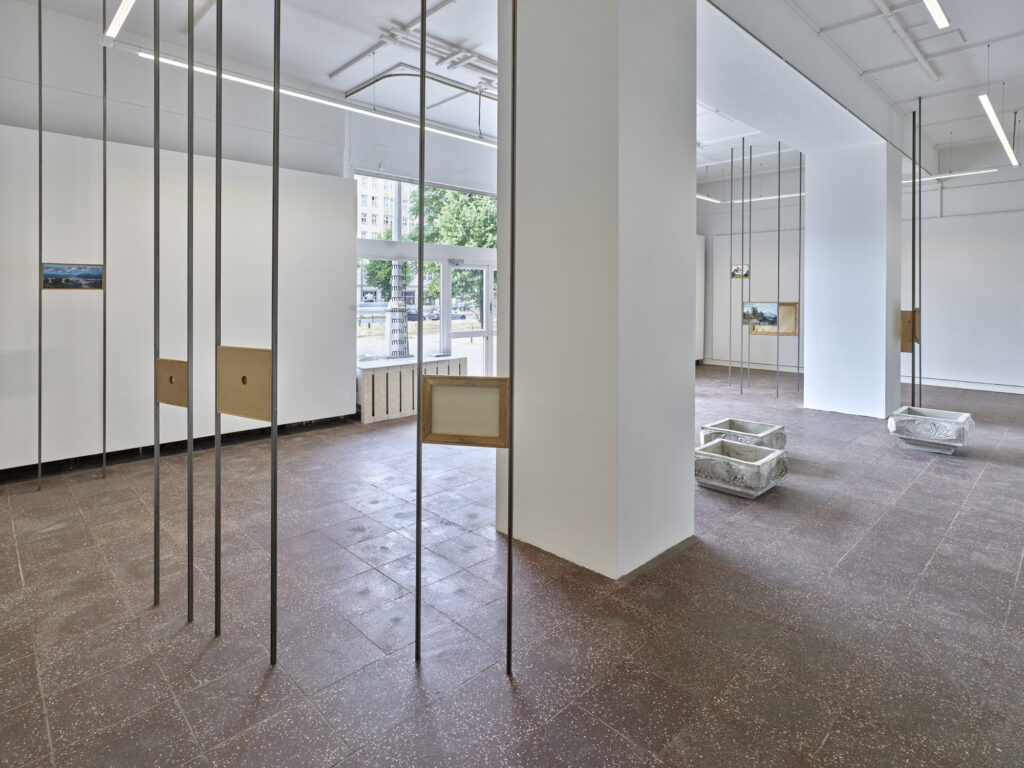
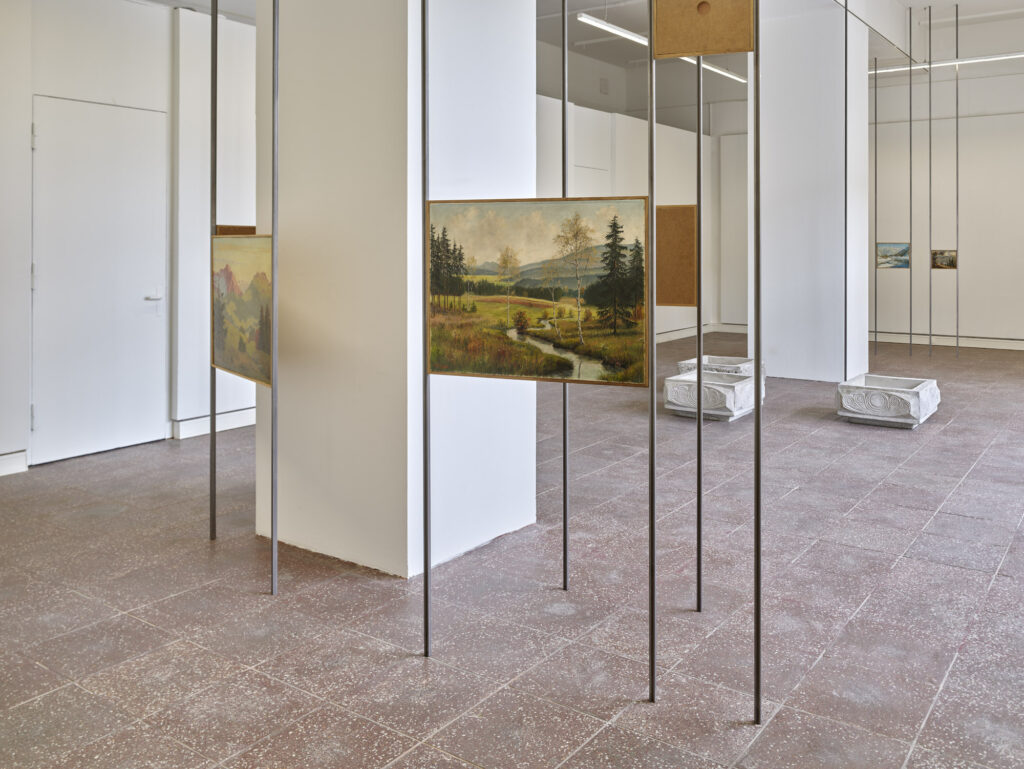
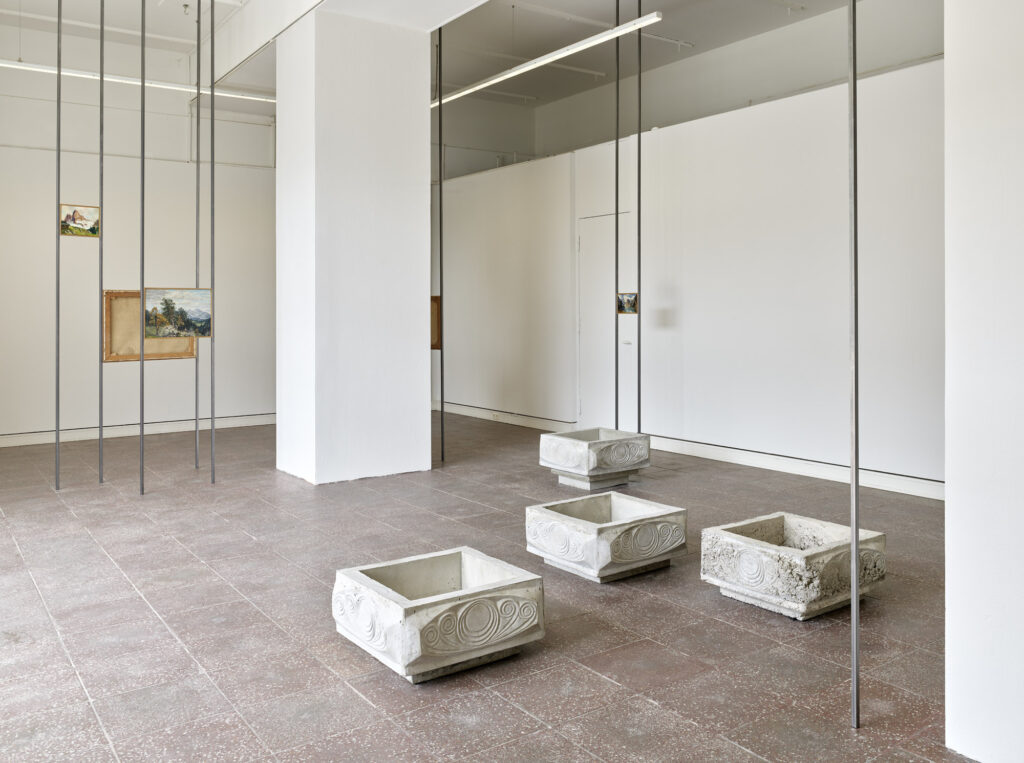
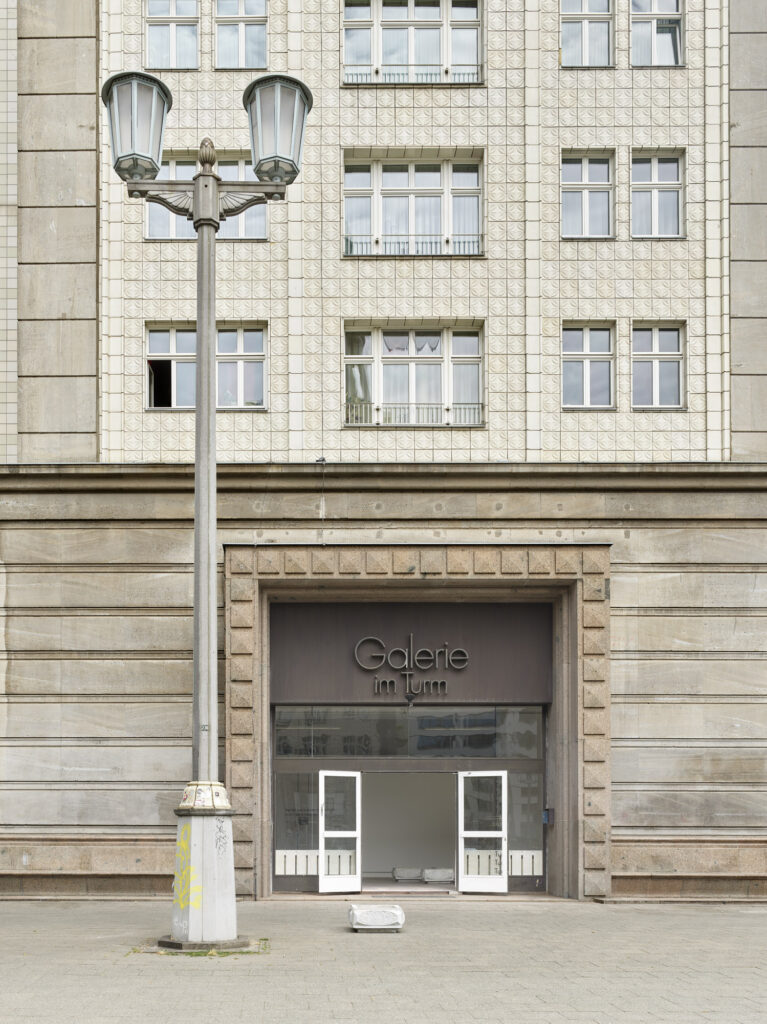
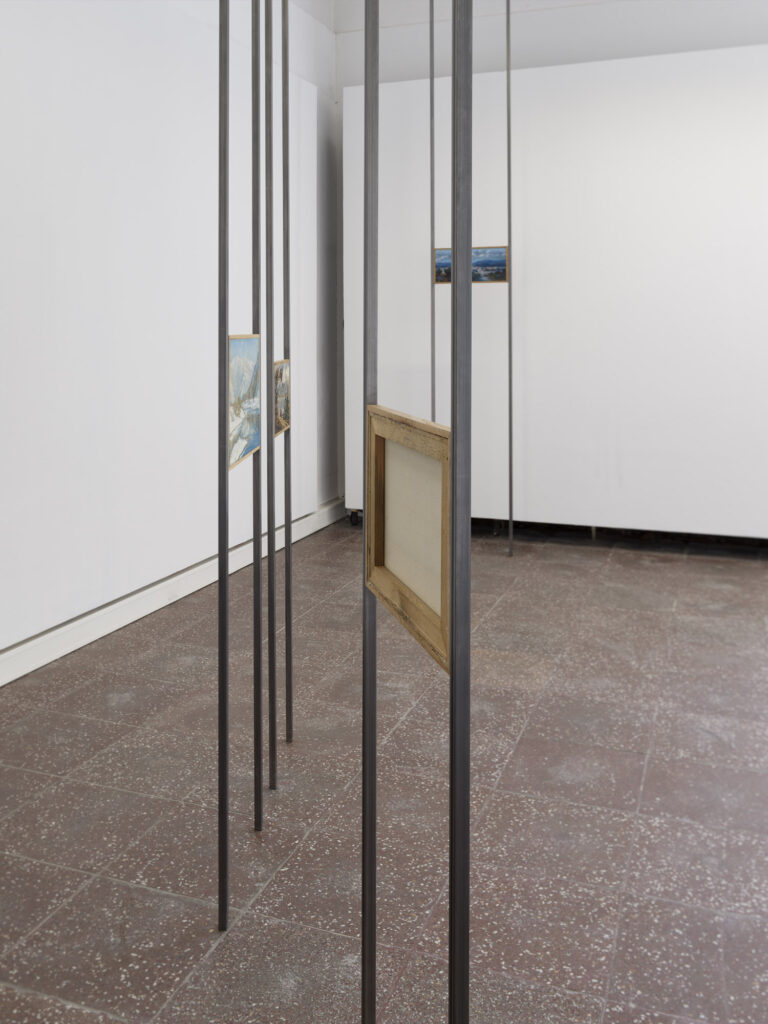
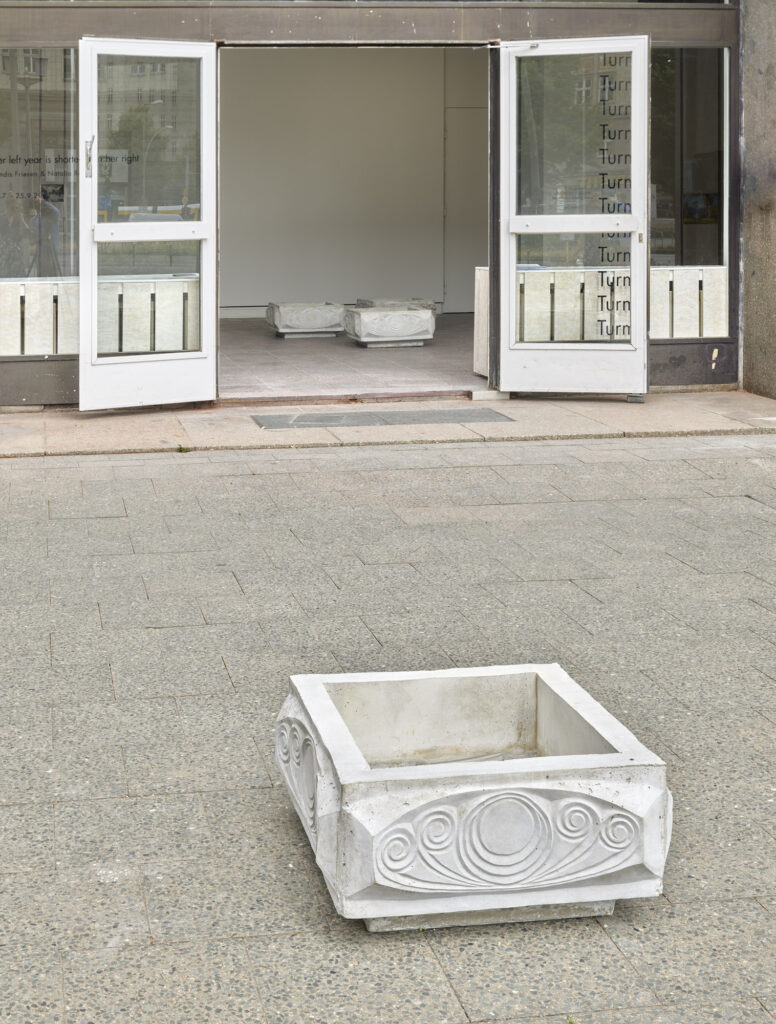
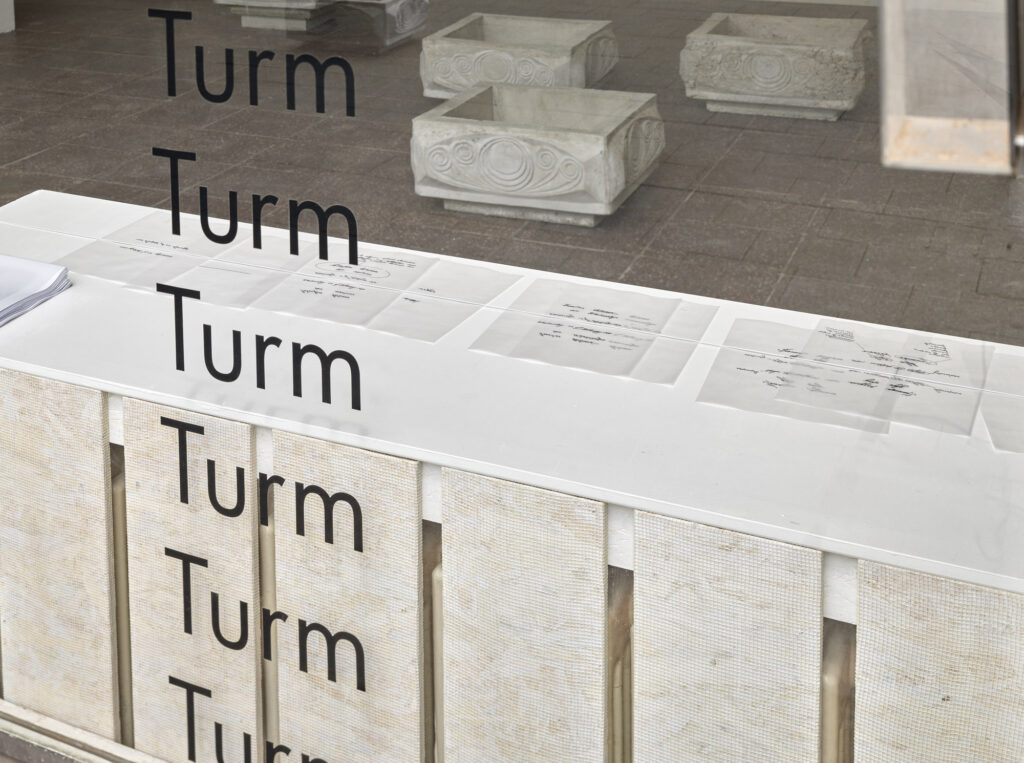
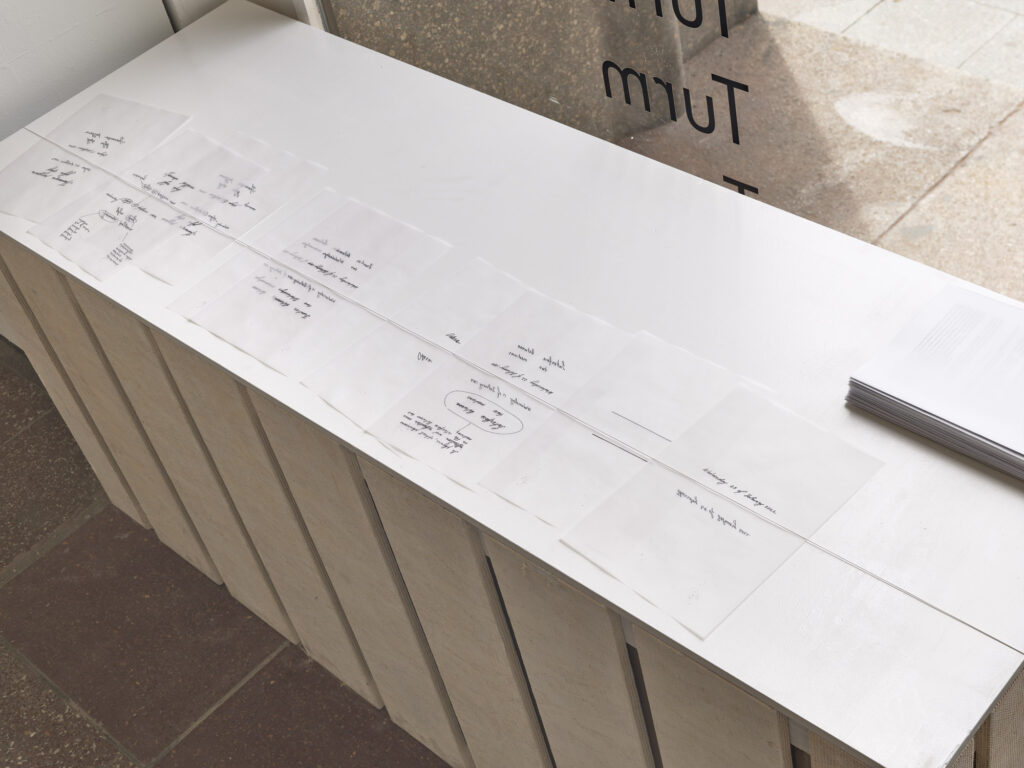
those that slip among molecules
Kim Bode
28.04. – 03.07.2022
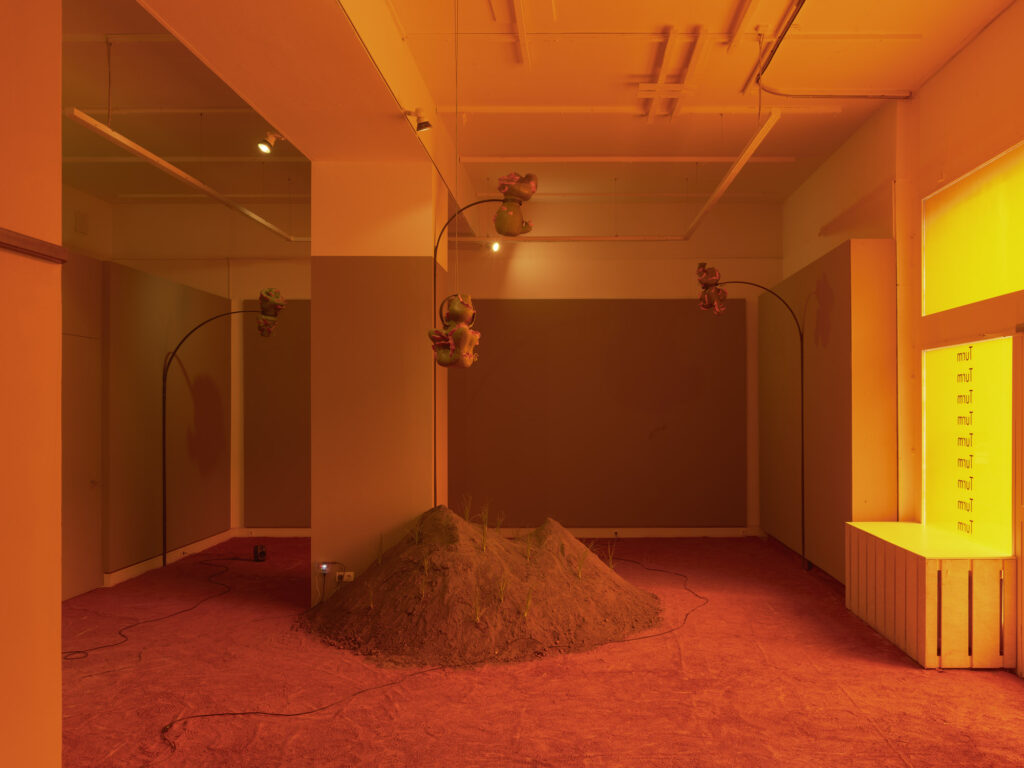
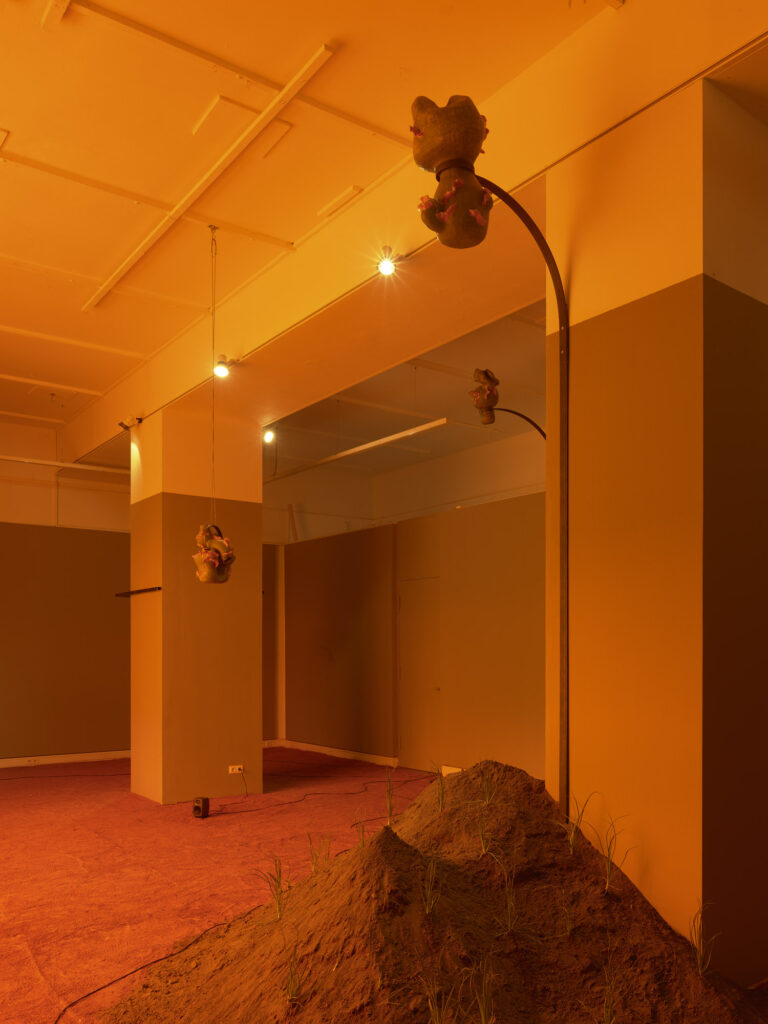

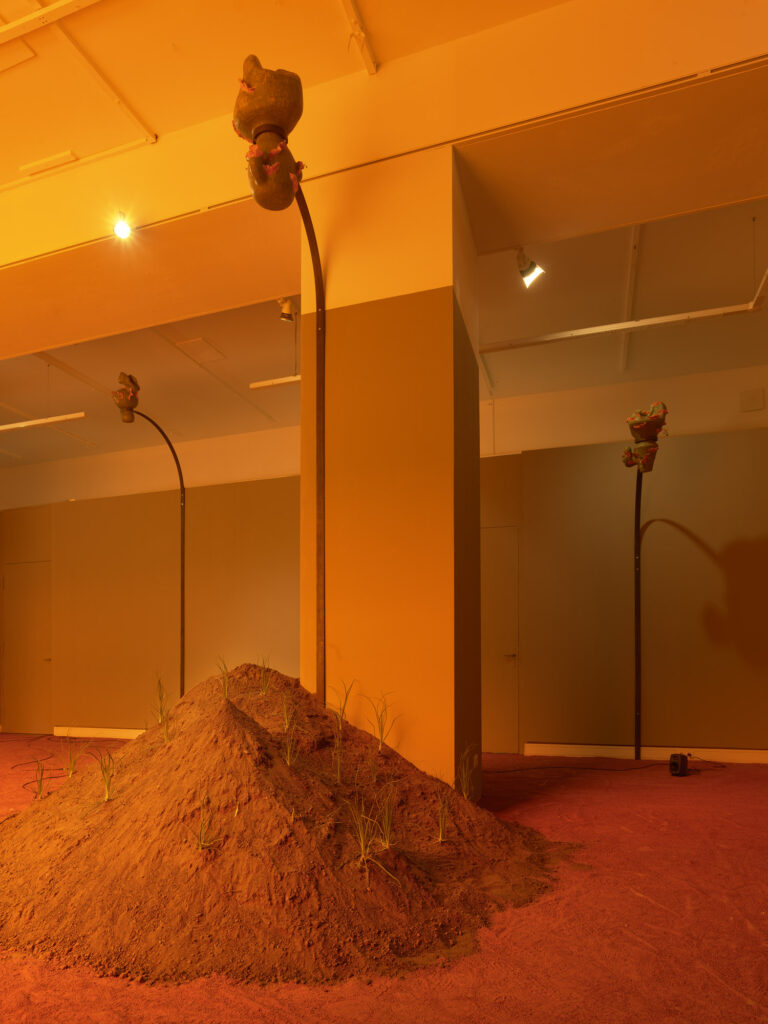
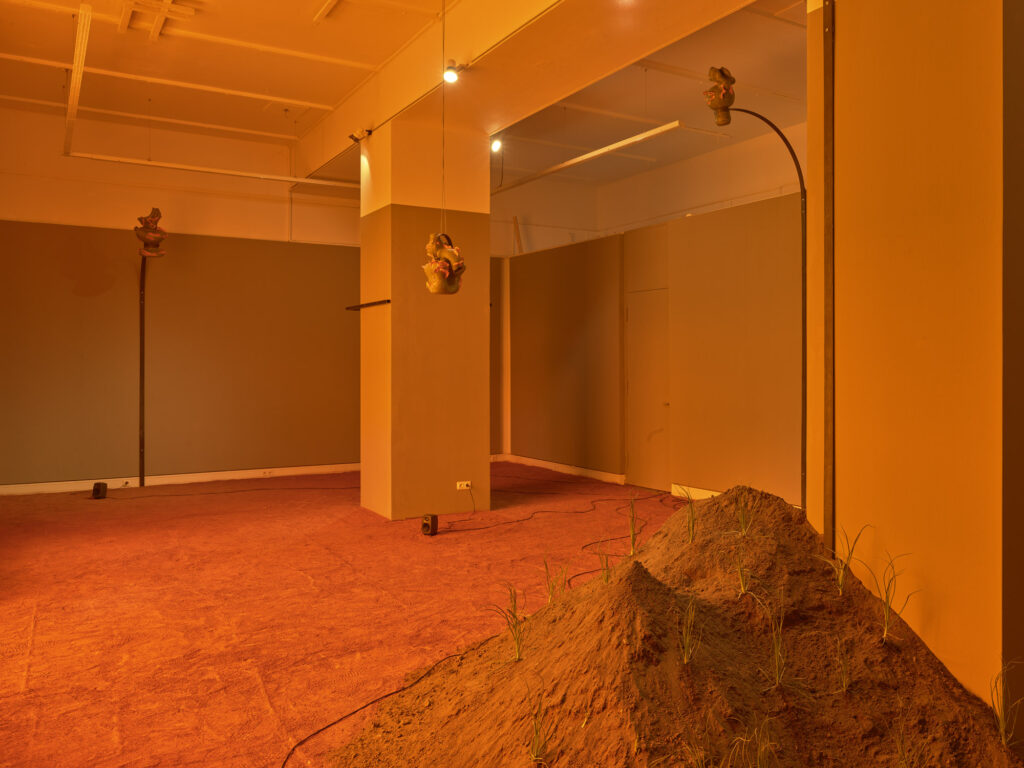
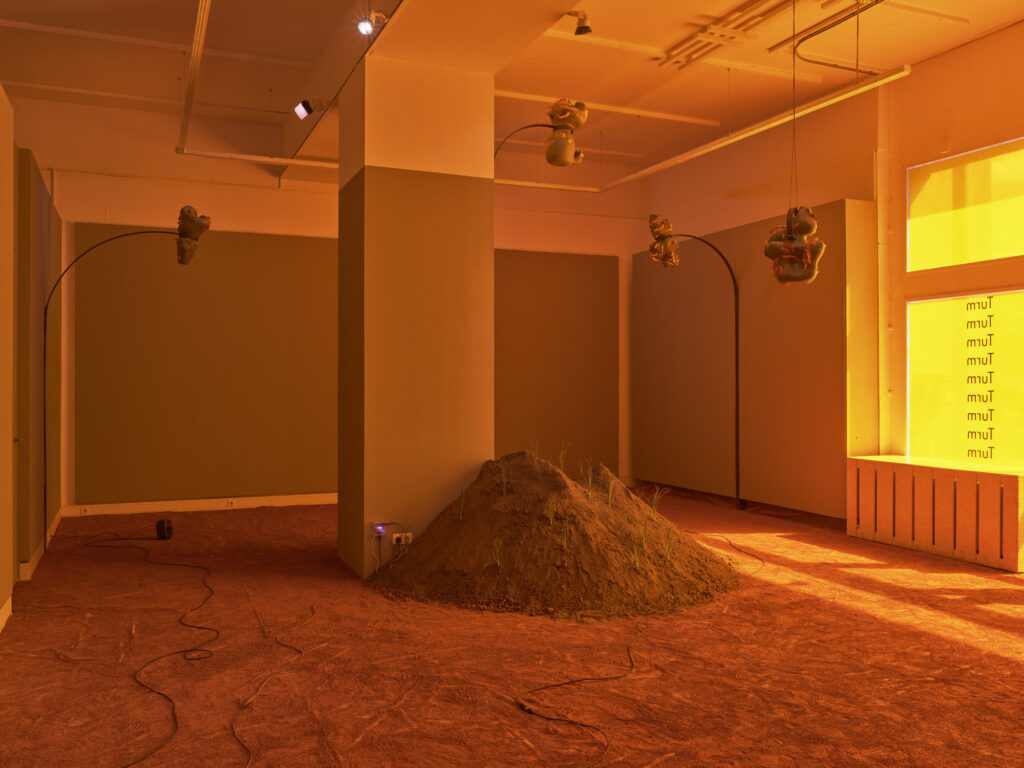
MY WORKING WILL BE THE WORK. on self/care, labour and solidarity
Exhibition series, 2020 – 2022
Curated by Linnéa Meiners and Jorinde Splettstößer
In the two-year programme at Galerie im Turm, art work is understood as a praxis of solidarity, of taking part in collectively building a different future. In six exhibitions, positions are shown that question established notions of work, and that unmaintain patriarchal, colonial, and capitalist principles.
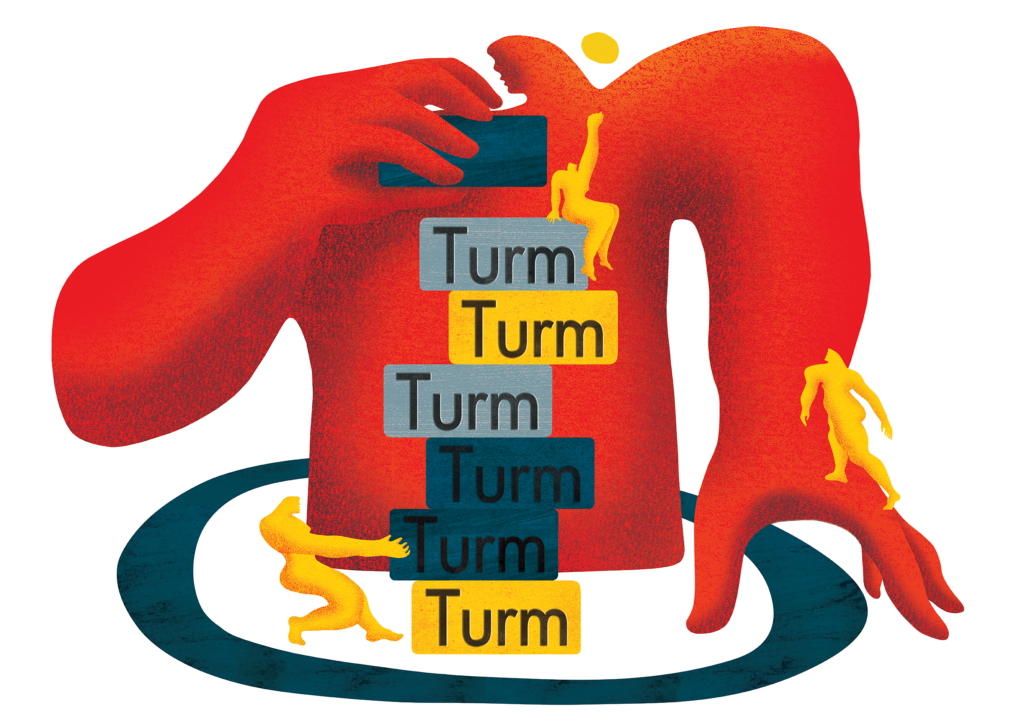
Filmmaker Alexandra Weltz-Rombach accompanied the exhibition series for two years.
MAROPENG
Lerato Shadi
3. Feb–17. Apr 22
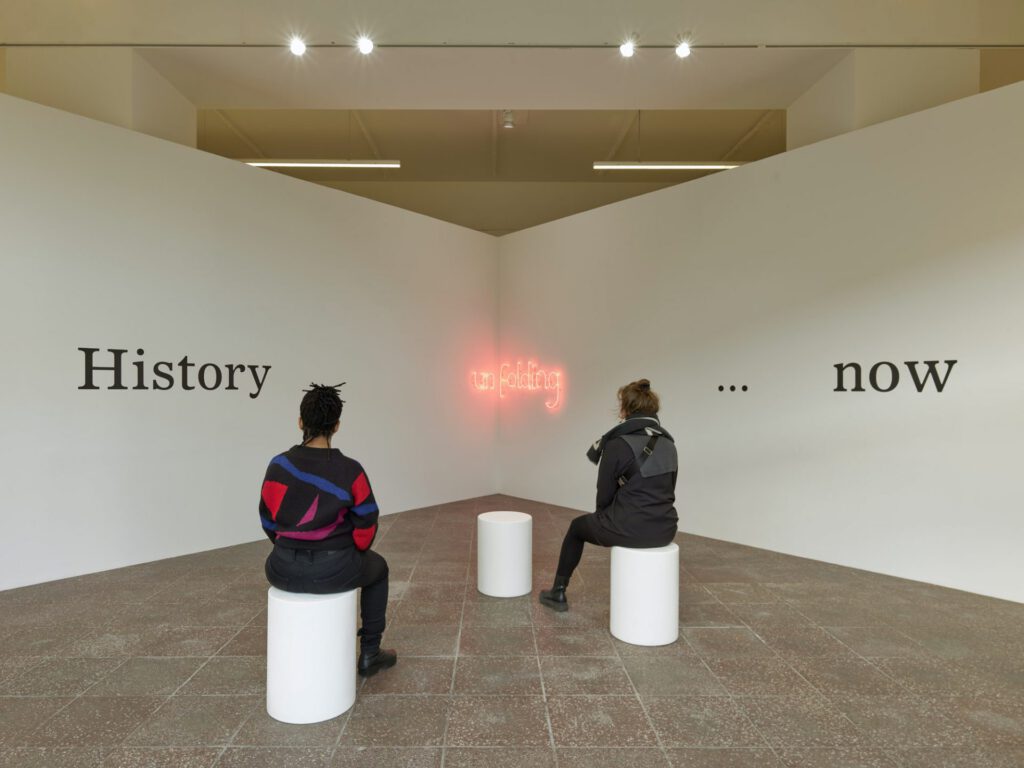
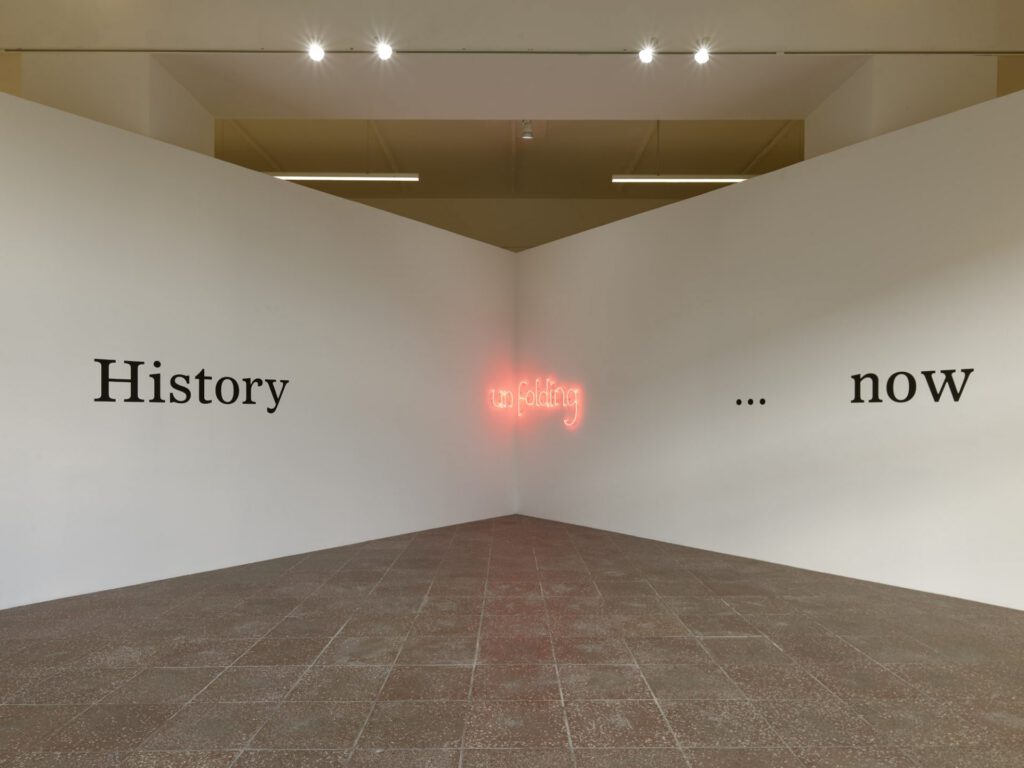
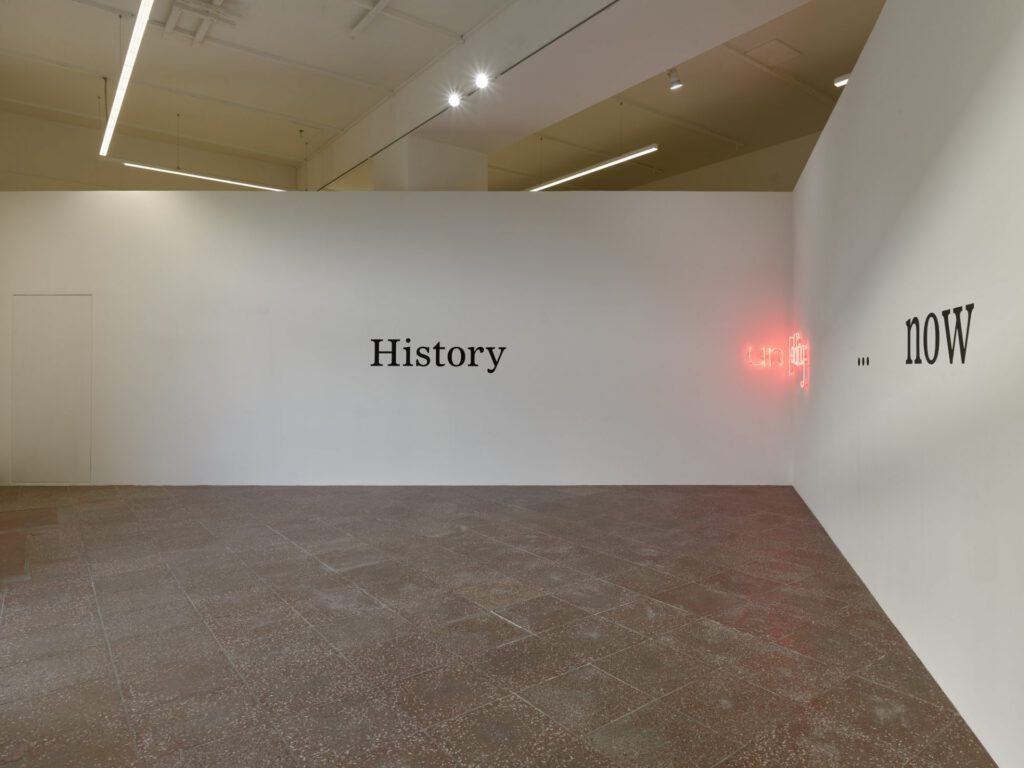
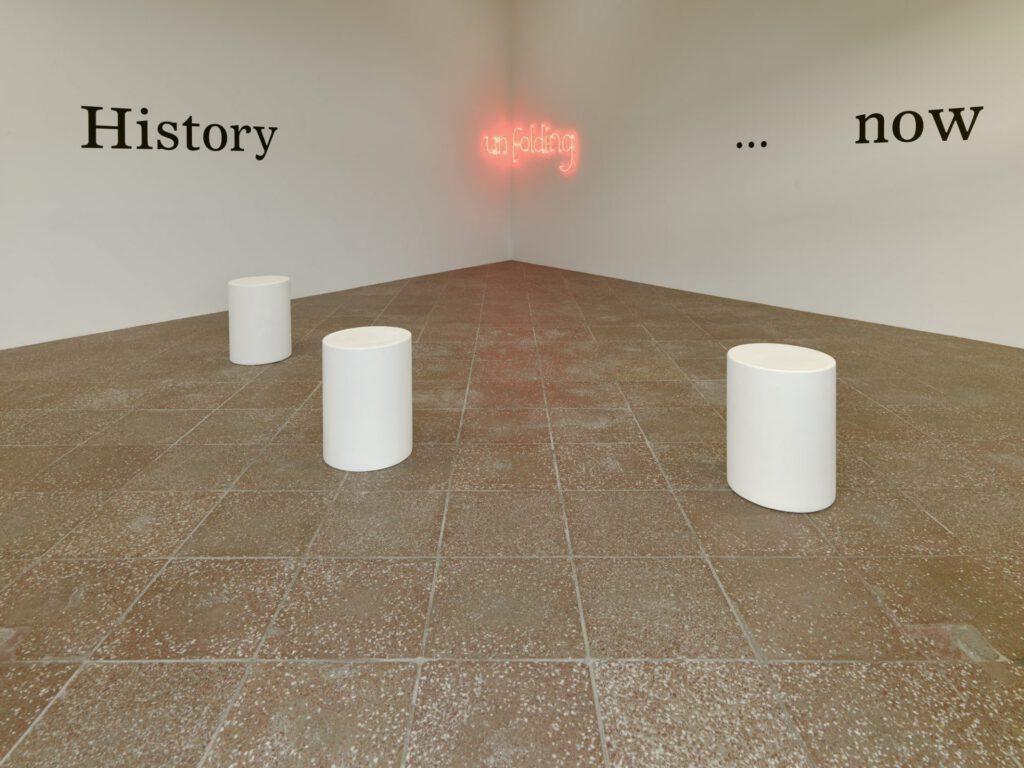
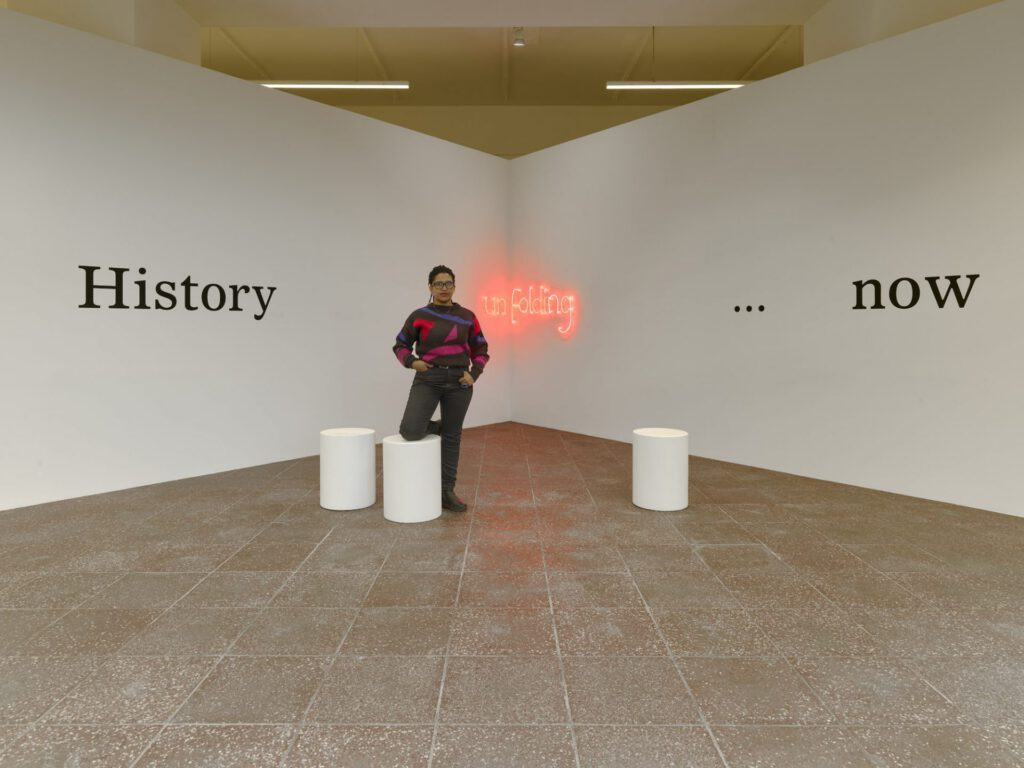
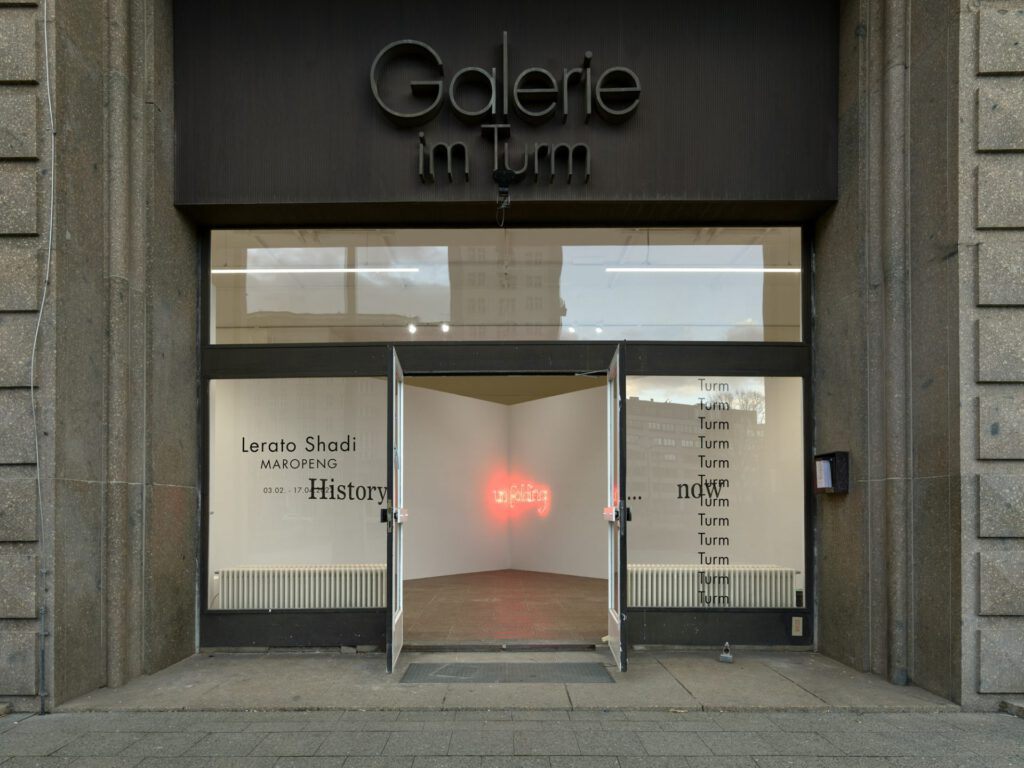
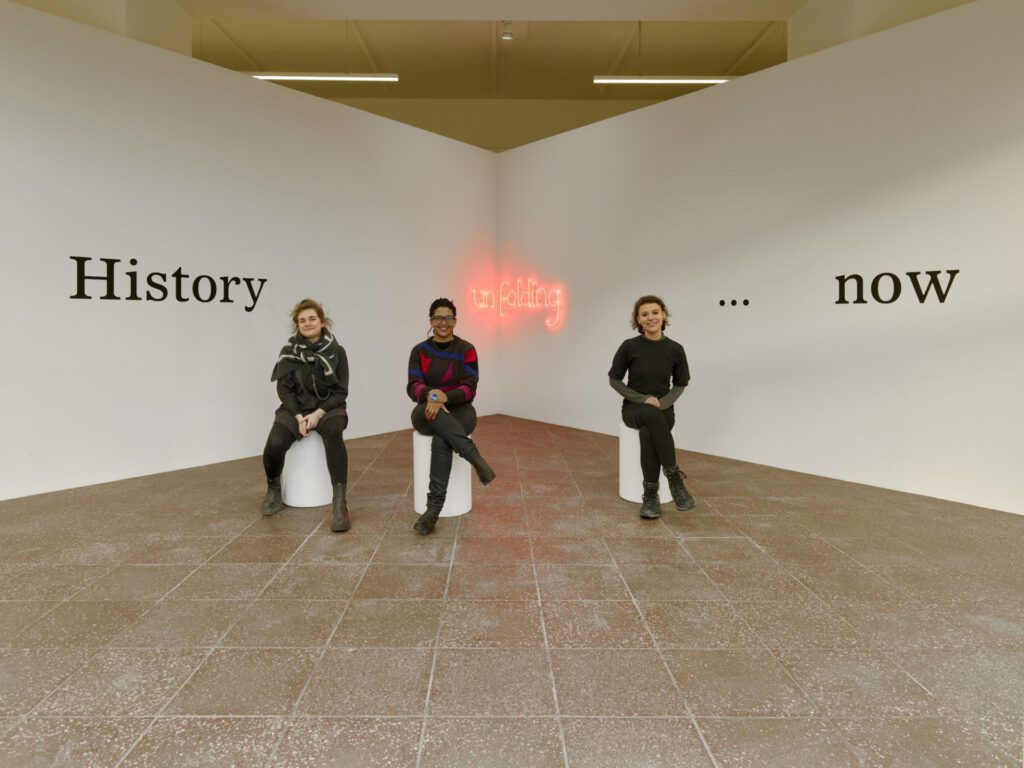
SLOW MOTION
Lola Arias
26.11.2021 – 23.01.2022
Revolting Spines and Shivering Chains
Romily Alice Walden, Bini Adamczak, Rüzgâr Buşki, Jesse Darling, Julia Lübbecke, Laura Fong Prosper
23.09. – 14.11.2021
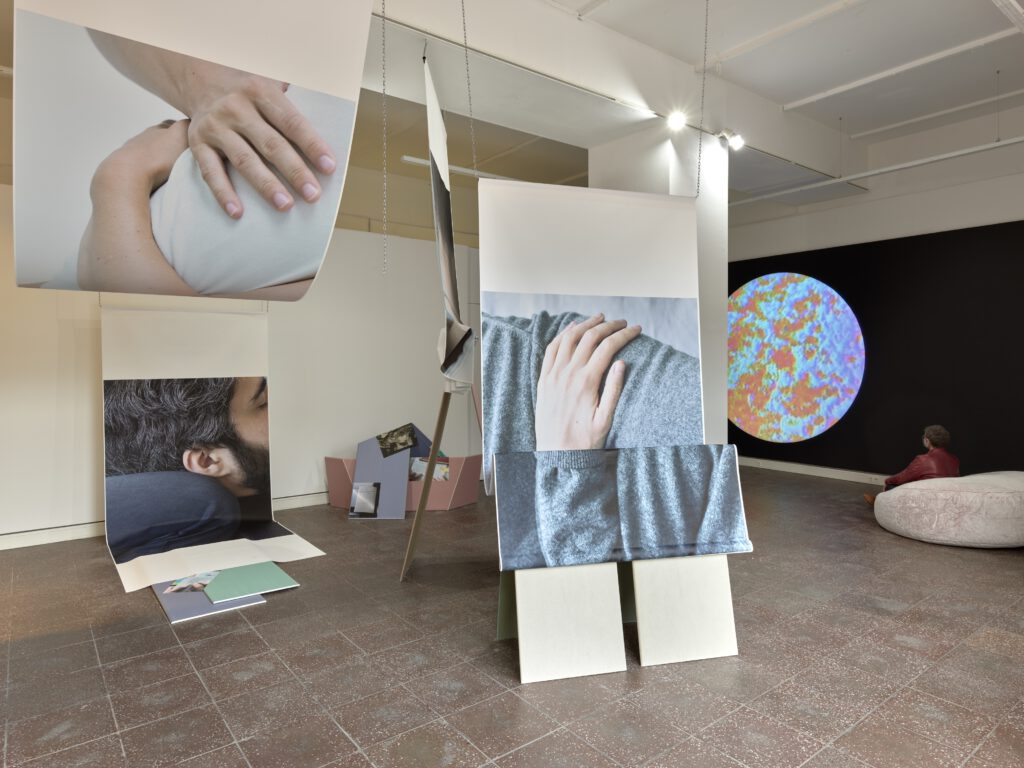
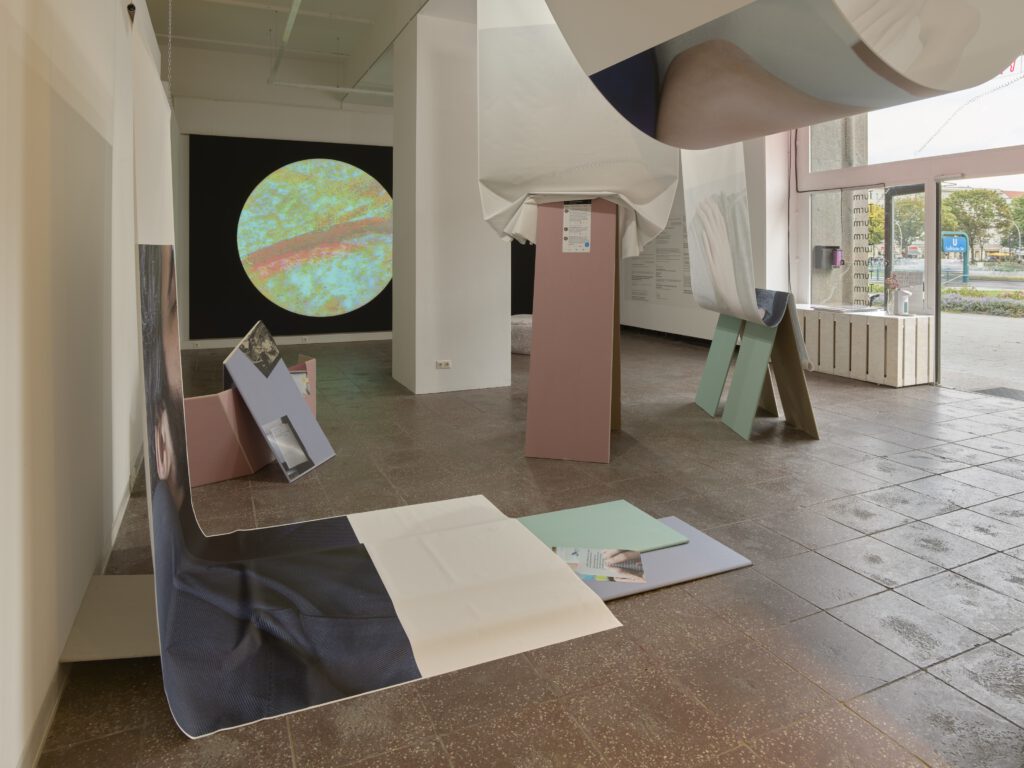
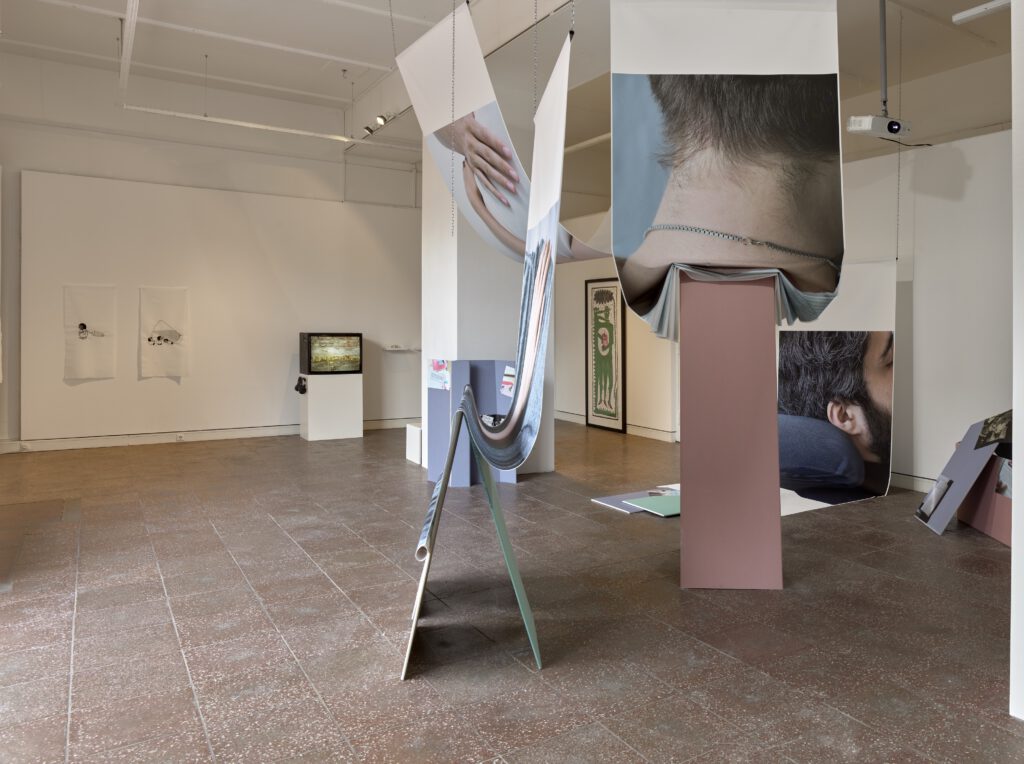
Liebe und Erschöpfung
Anike Joyce Sadiq
Konstanze Schmitt
08.07.2021 – 12.09.2021
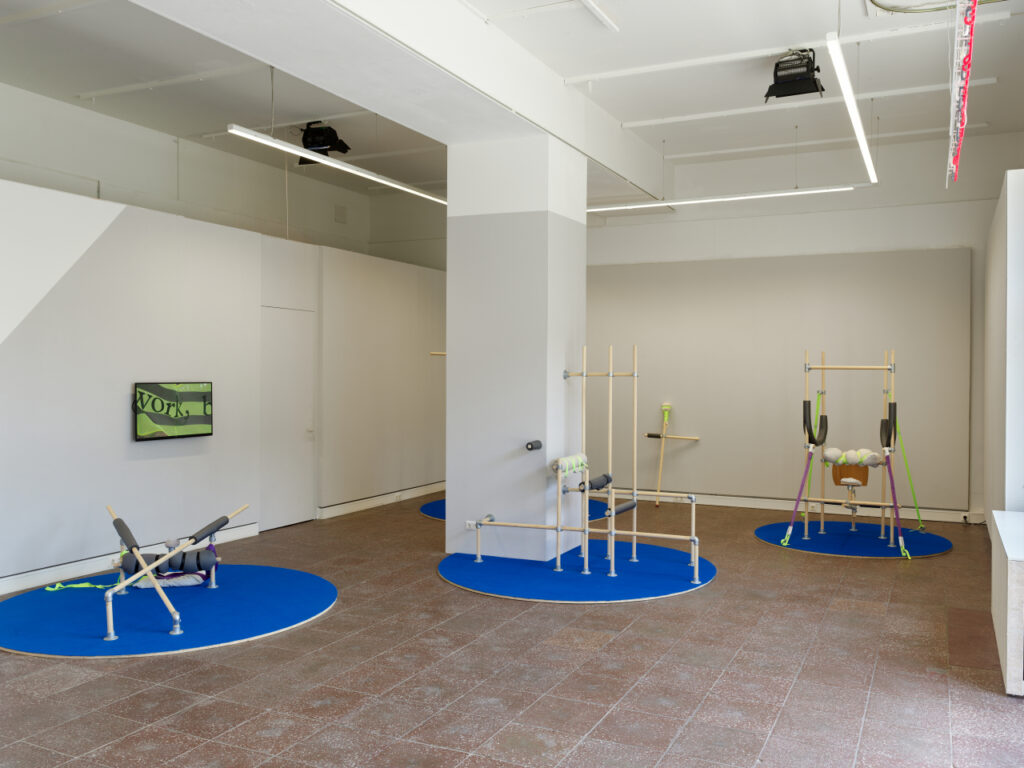
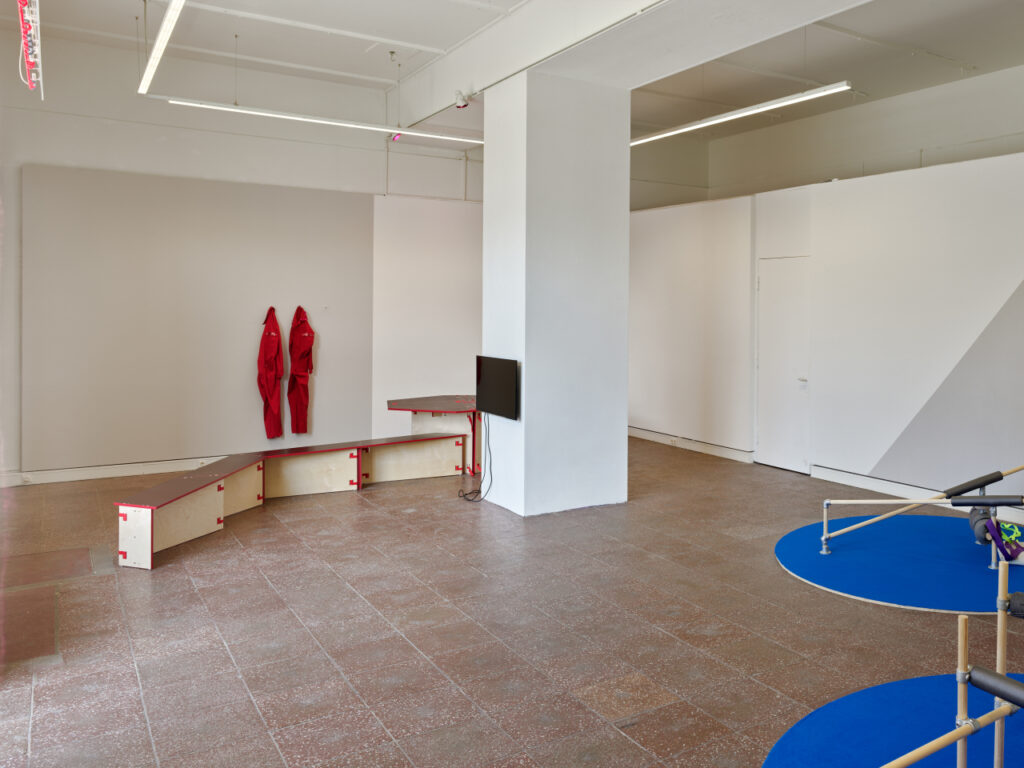

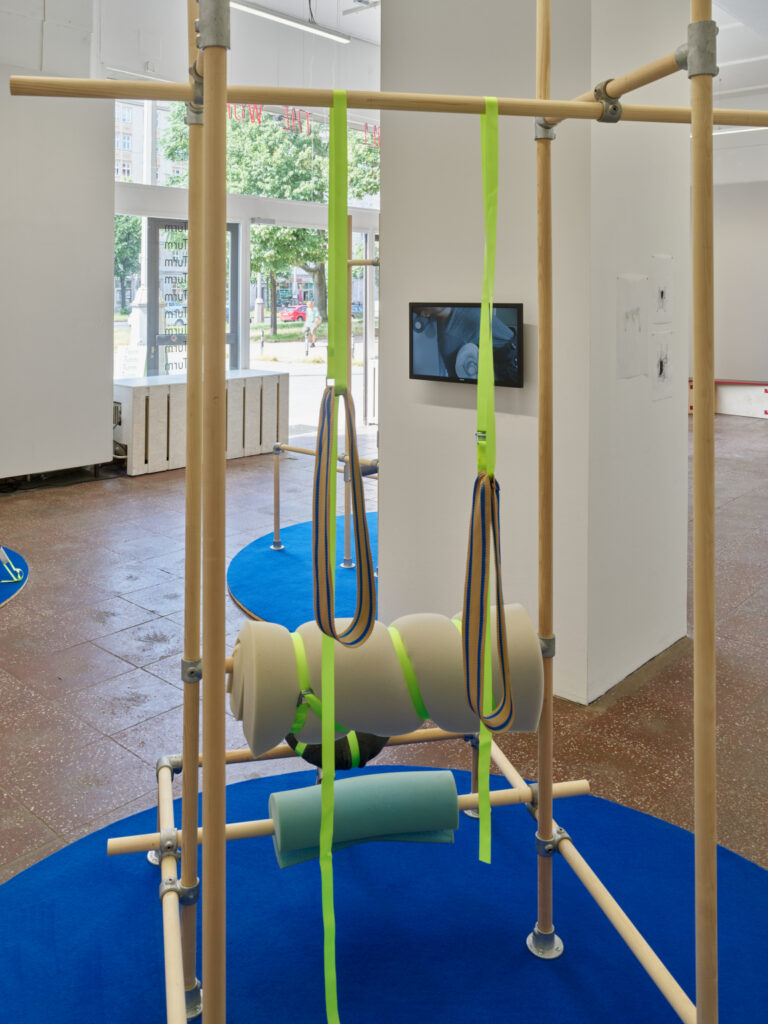
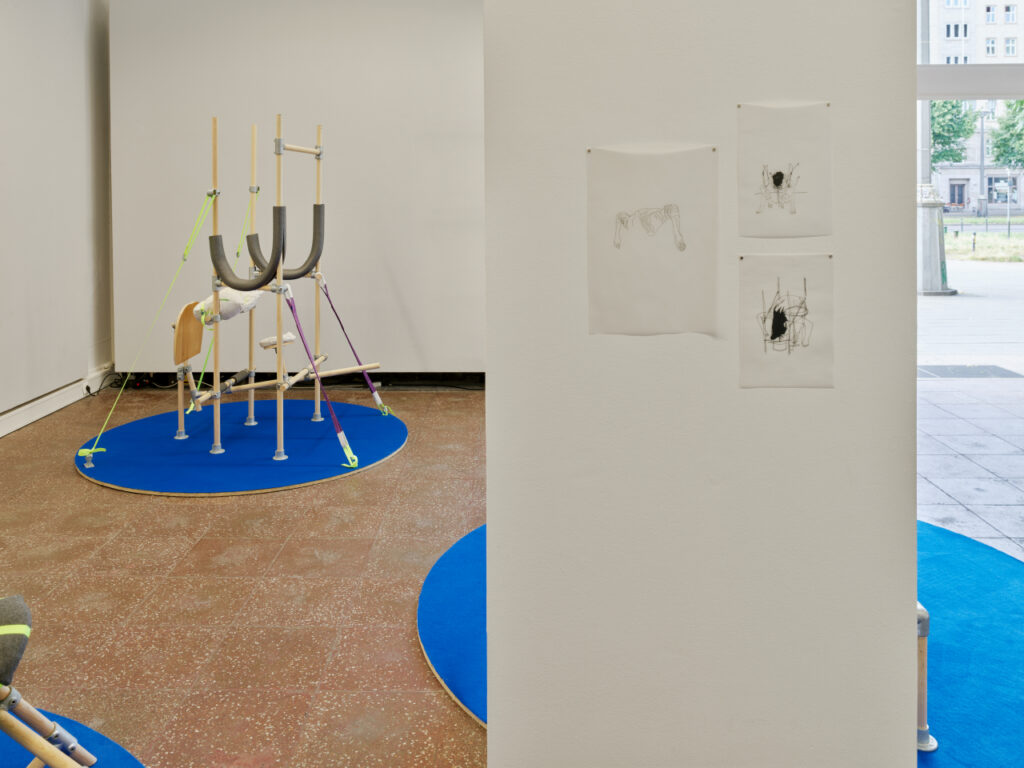

The End of the Fucking Work
Varvara Stepanova, Kathrin Lemcke, Natasha A. Kelly, Wayne Hodge, Harun Farocki, Anna Borgman und Candy Lenk
12.04.2021 – 27.06.2021
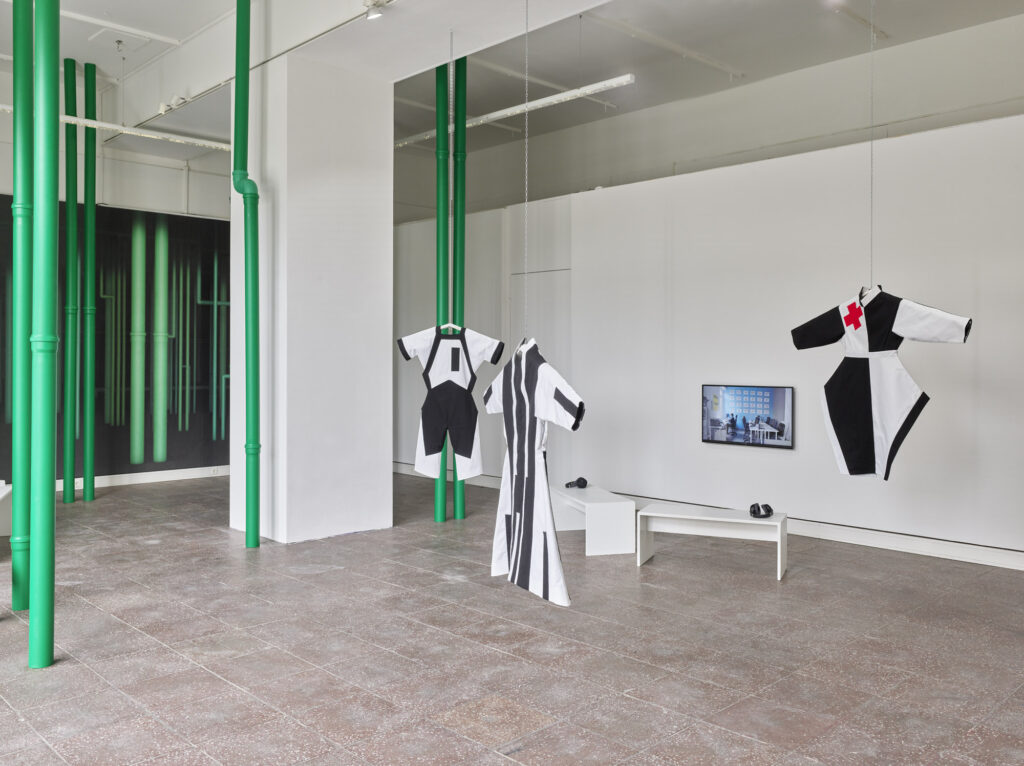
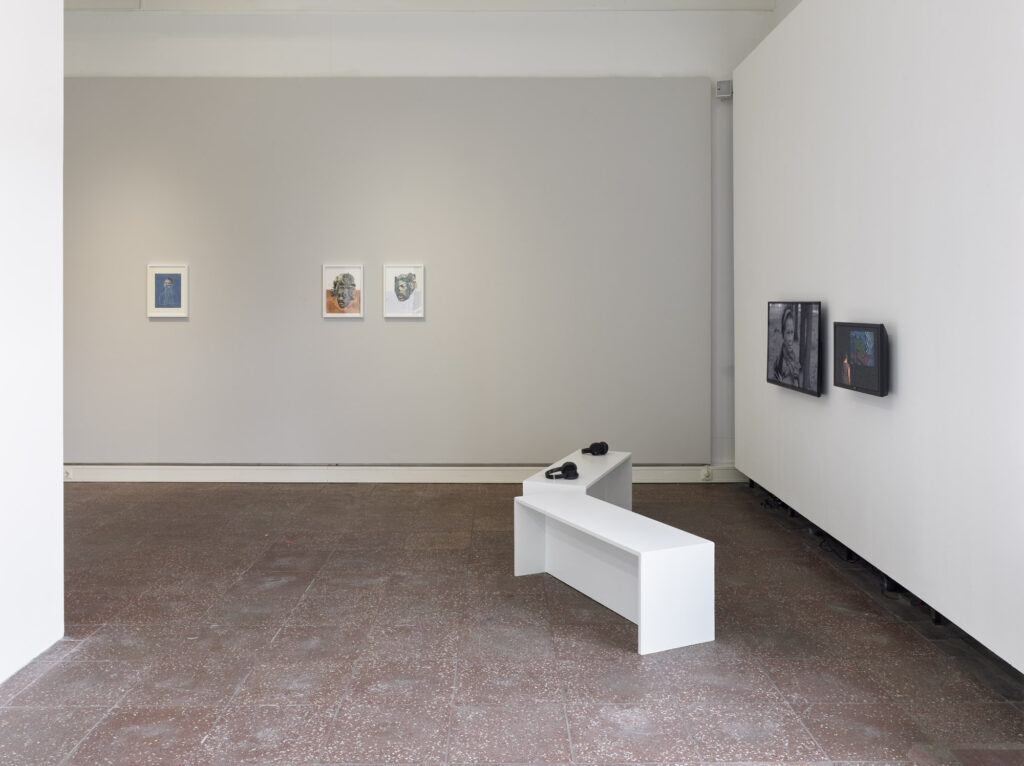
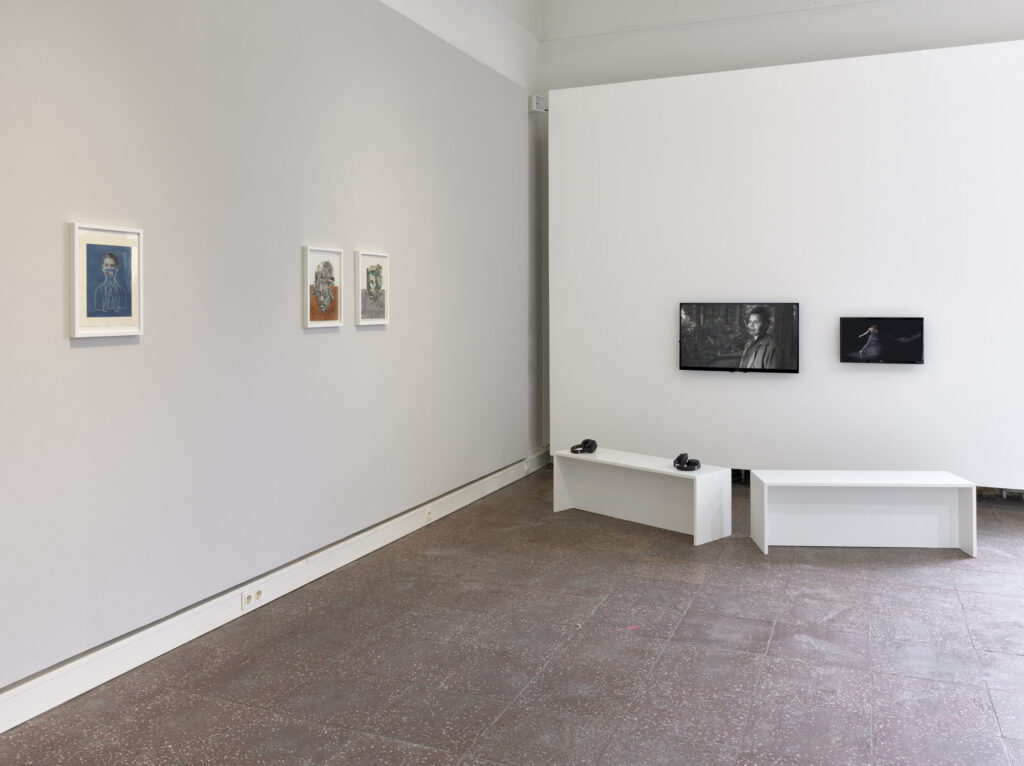
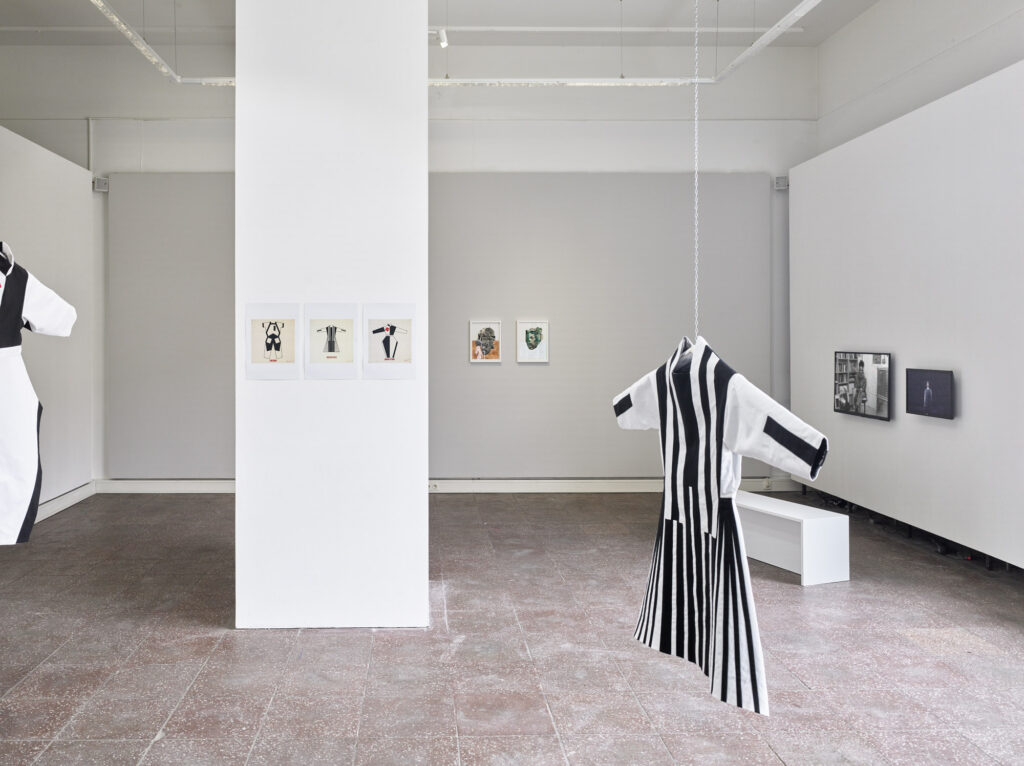
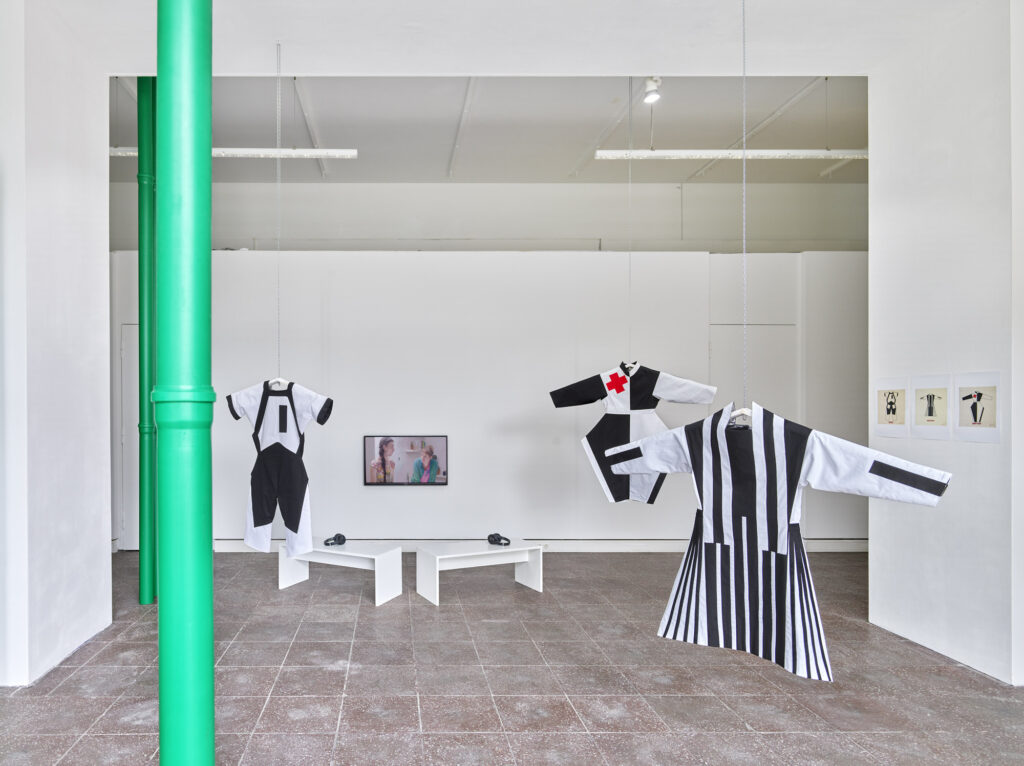
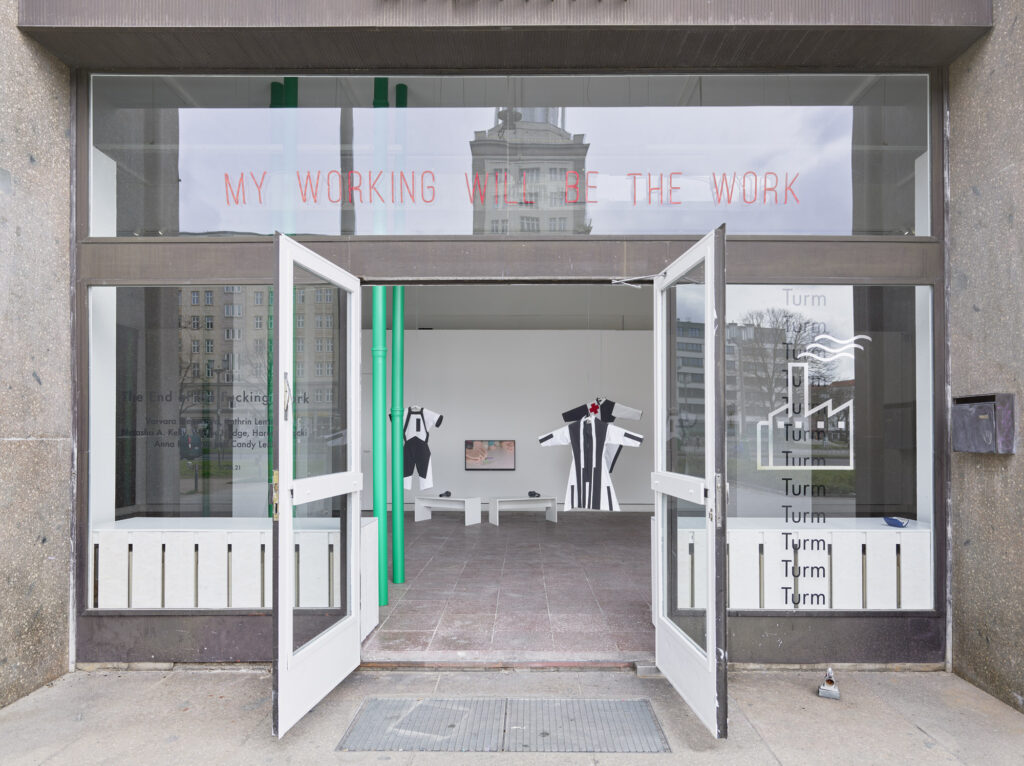
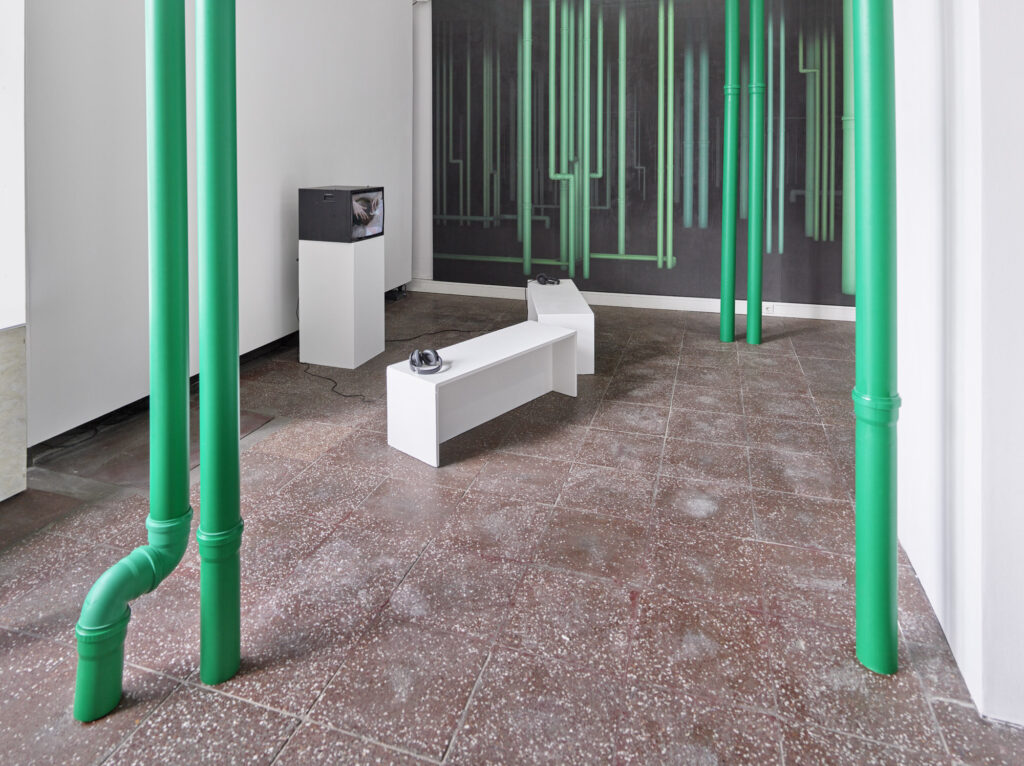
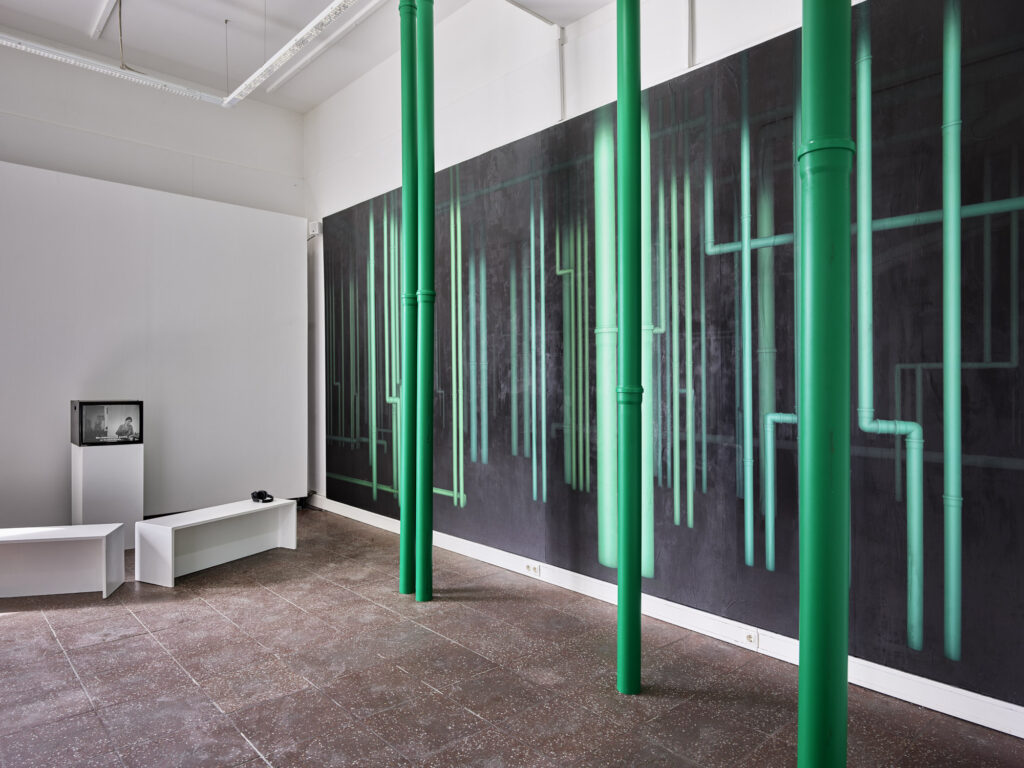
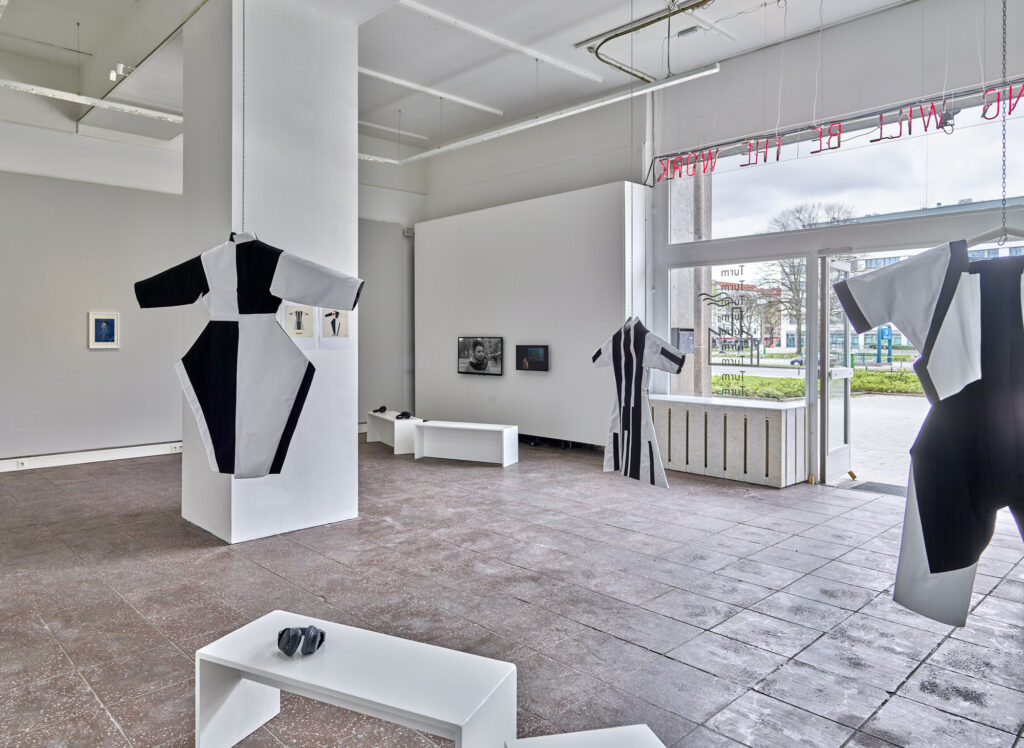
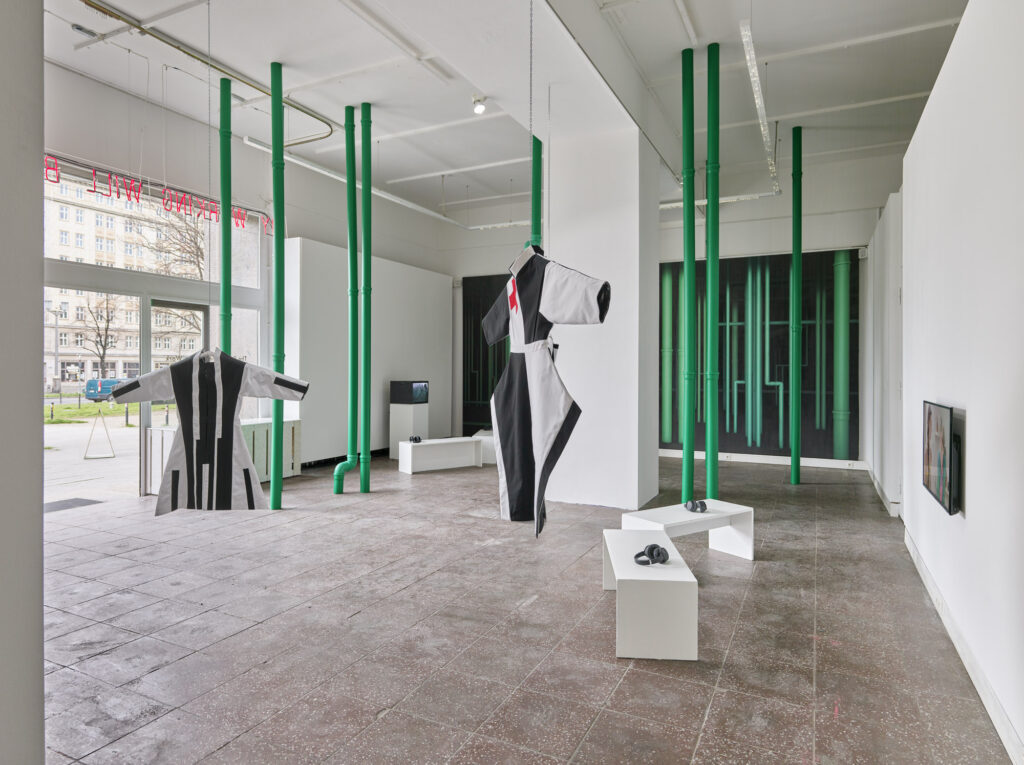
Hands Full of Air
Monilola Olayemi Ilupeju
10.12.20 – 28.03.21
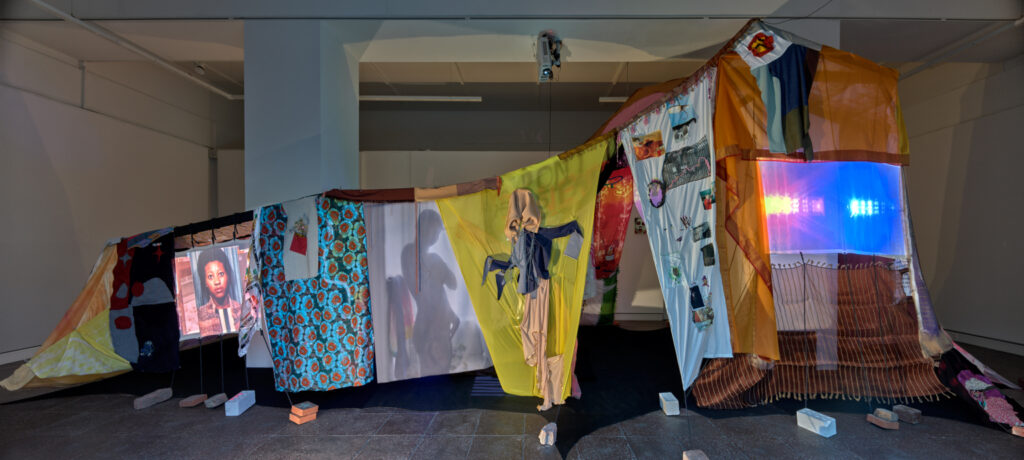
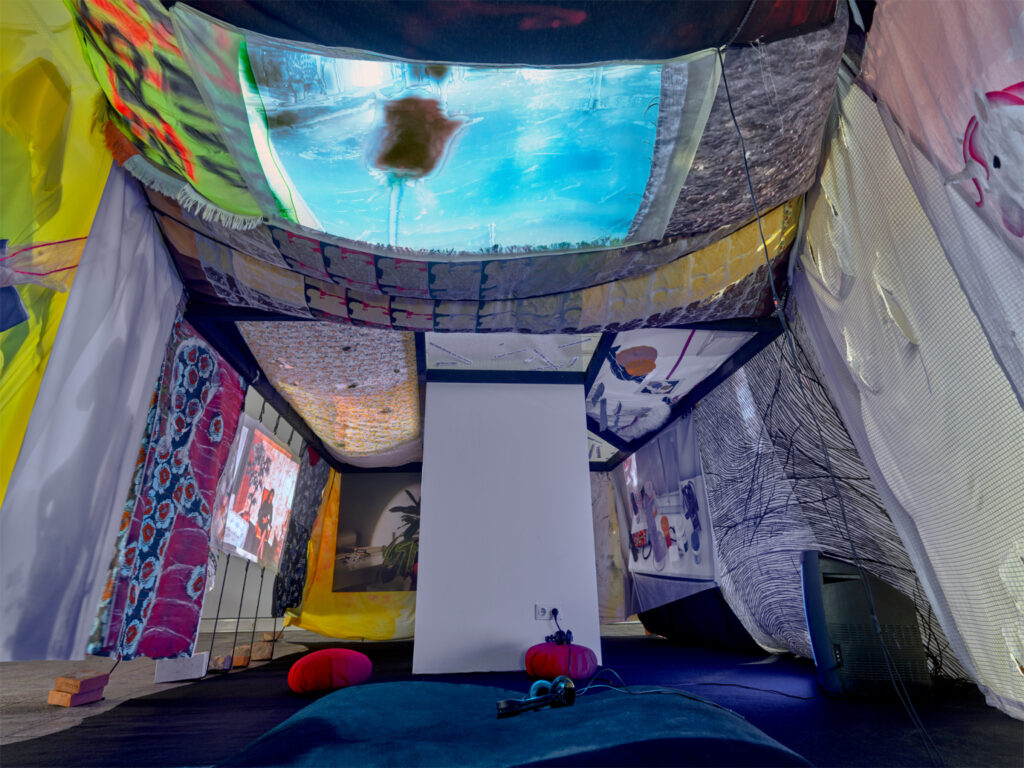
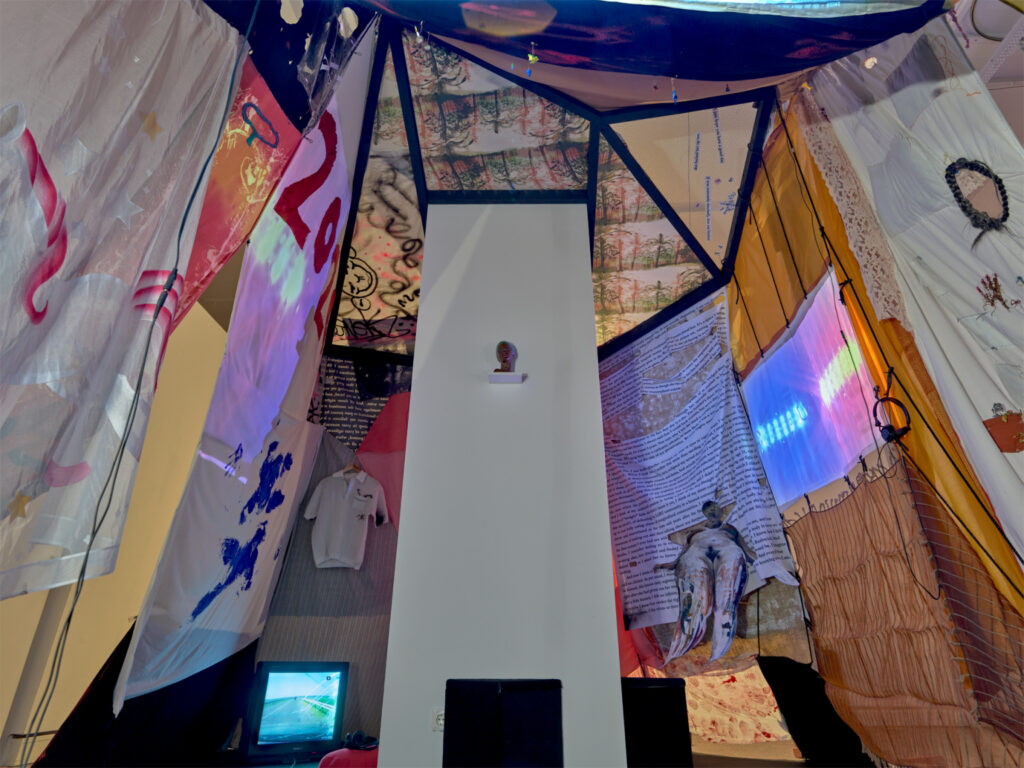

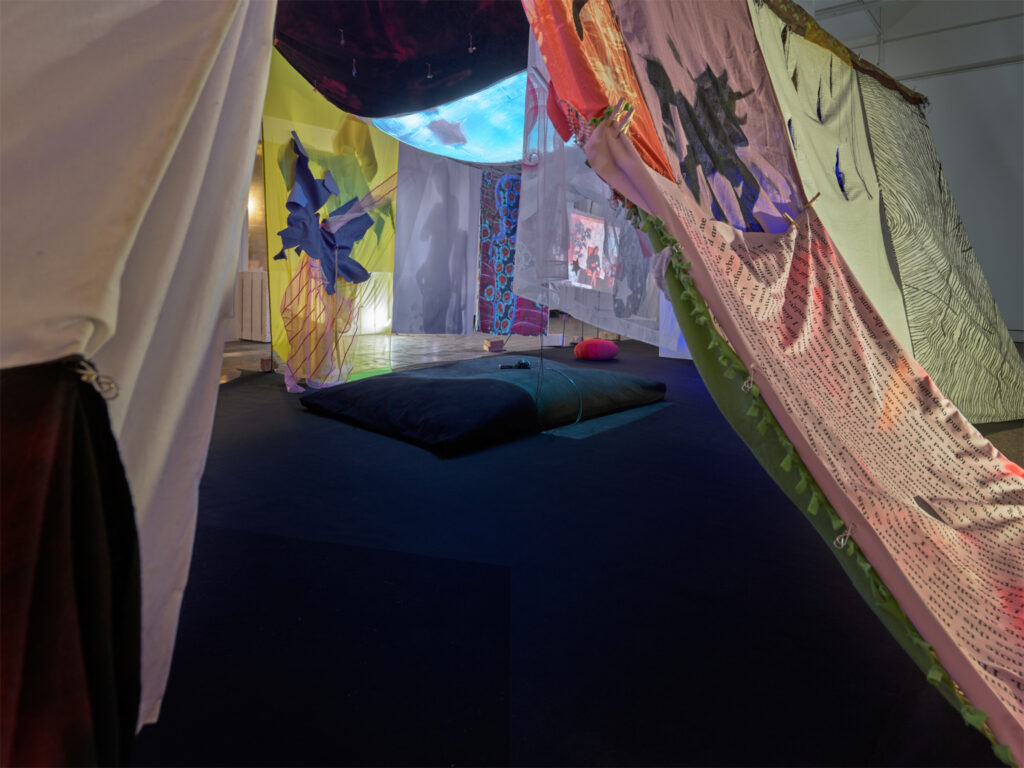
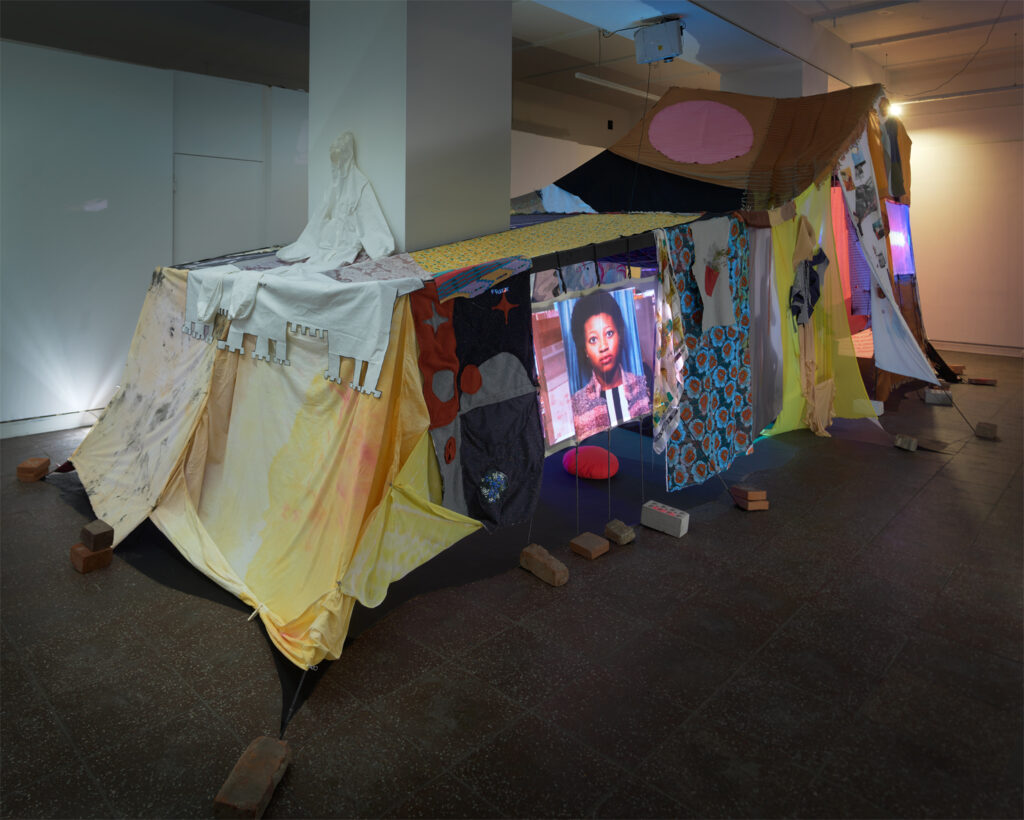
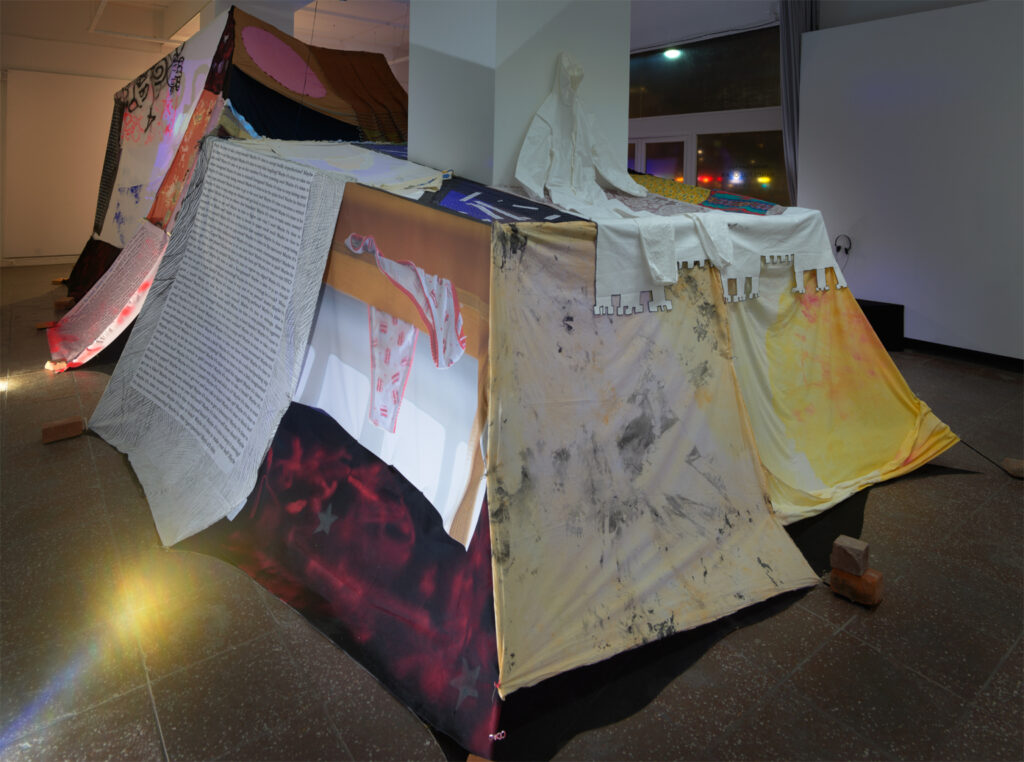
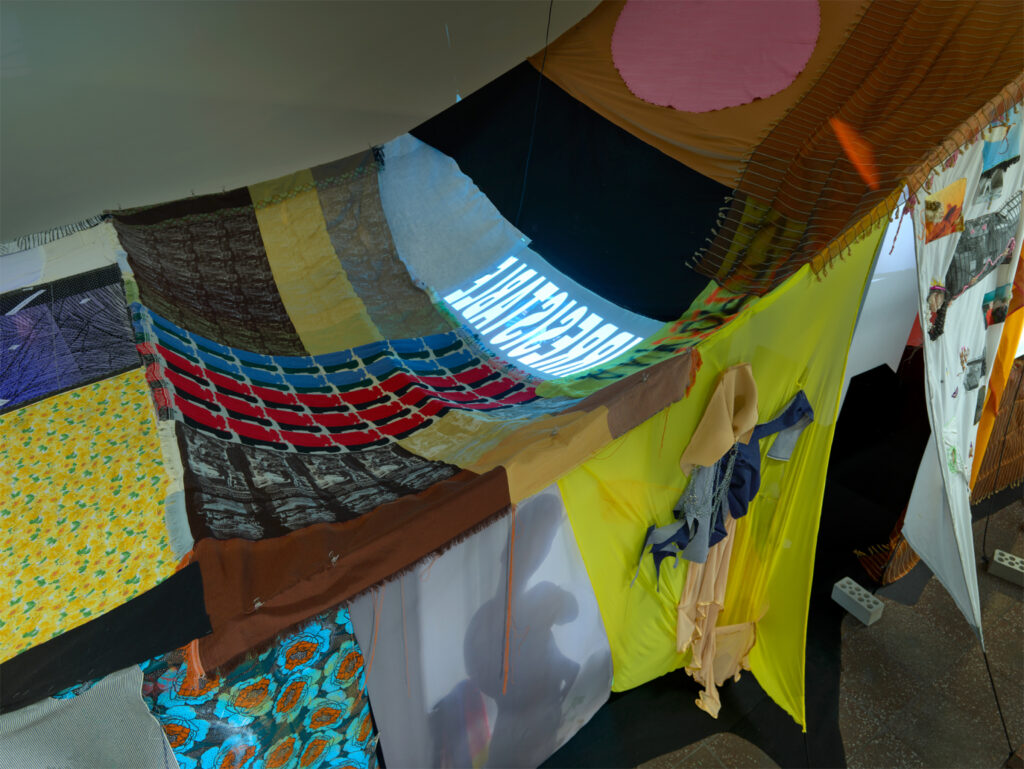
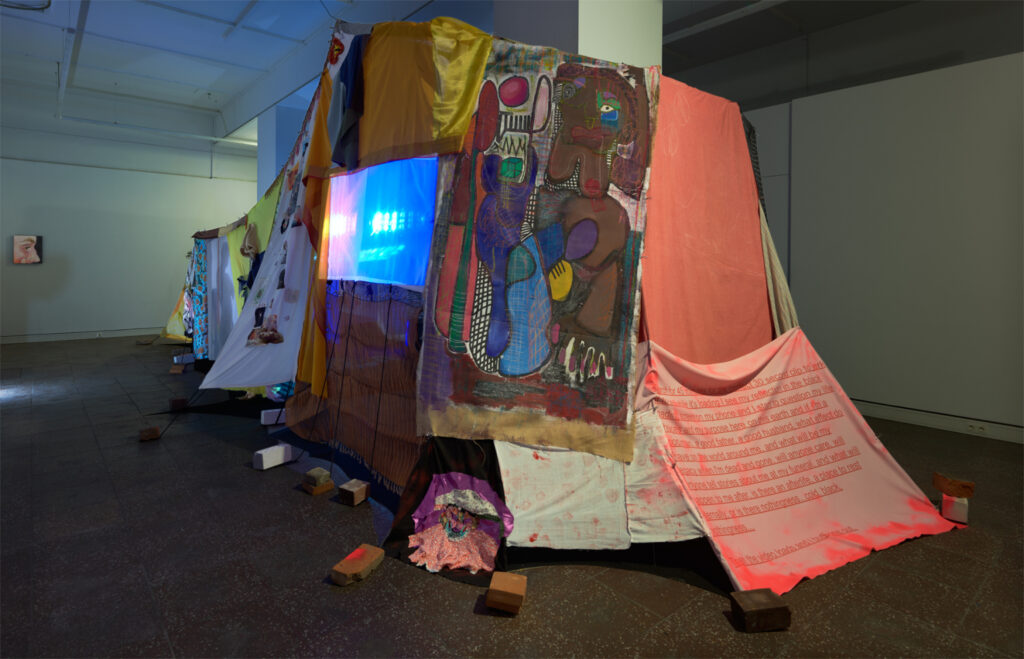
For Most of it I have no Words
Sophie Utikal
11.05.2020 – 05.07.2020
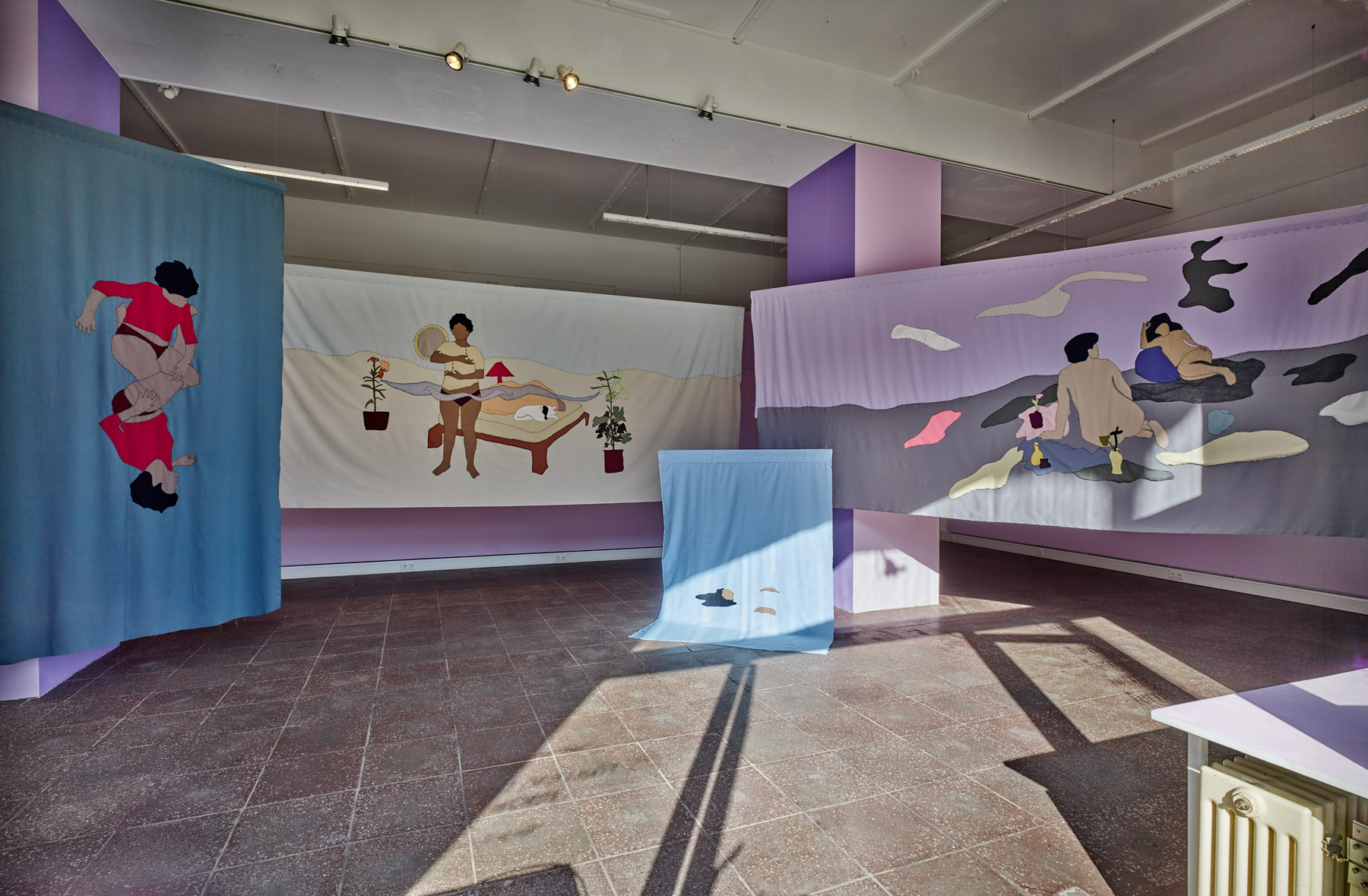
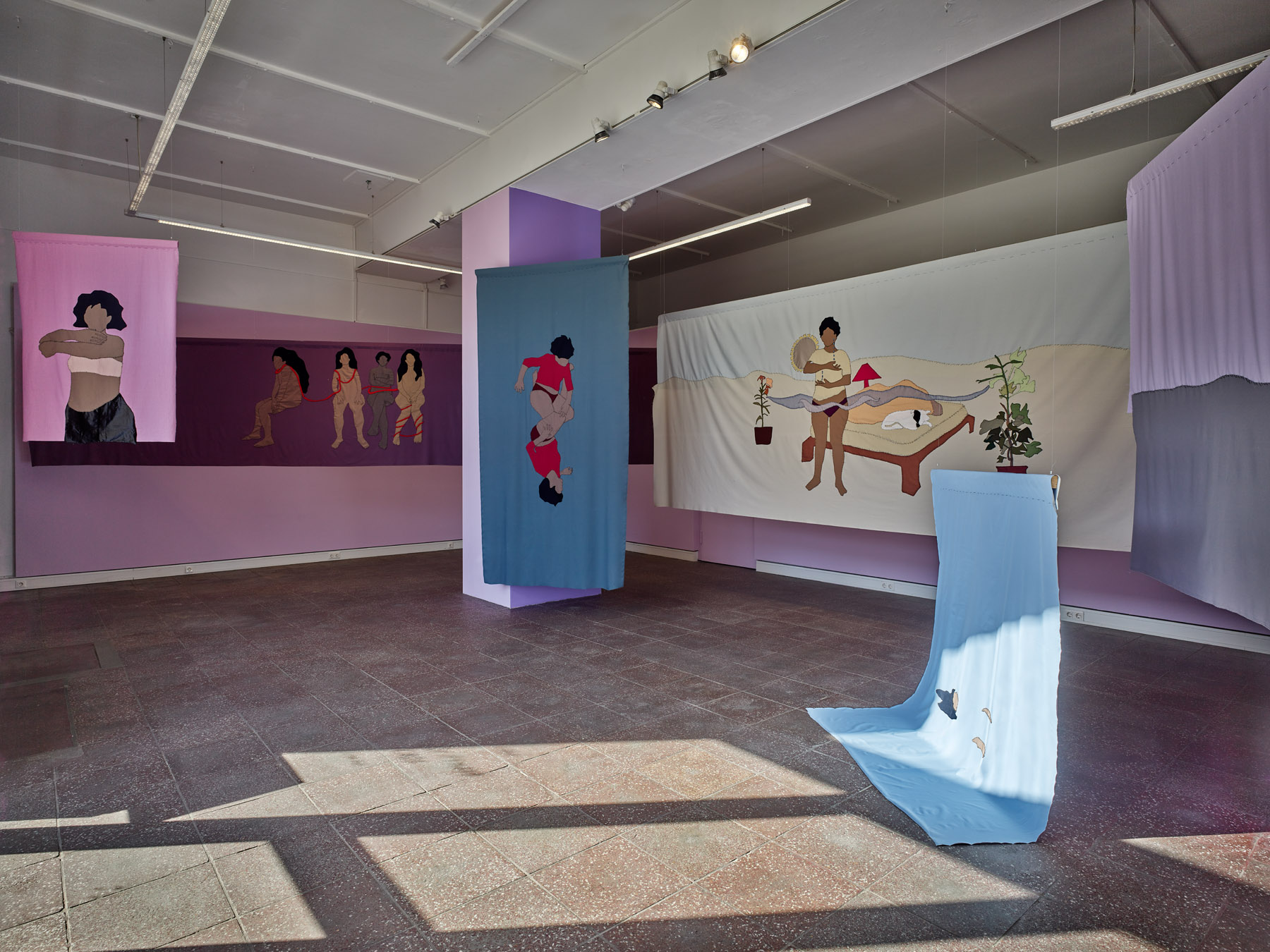
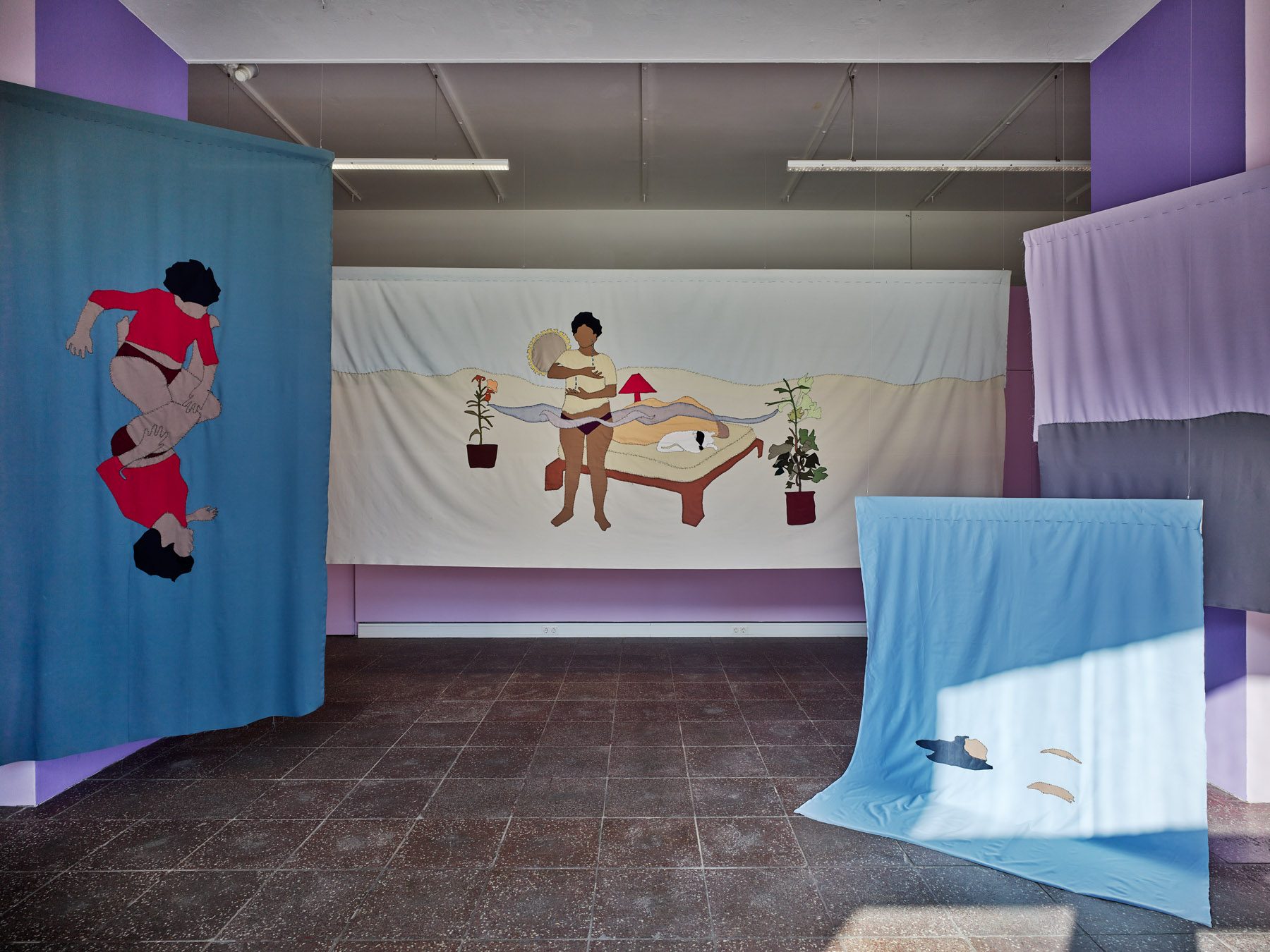
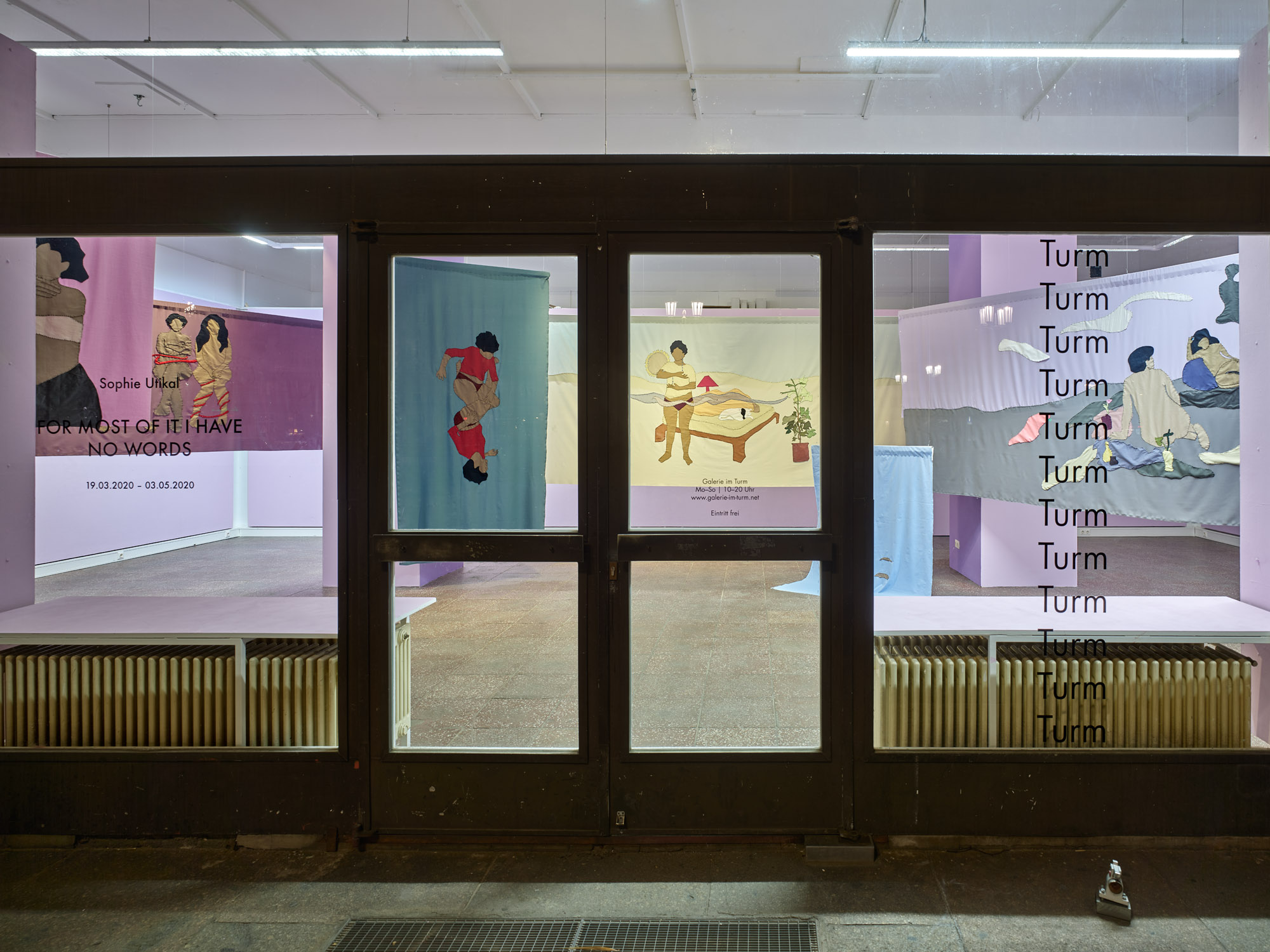
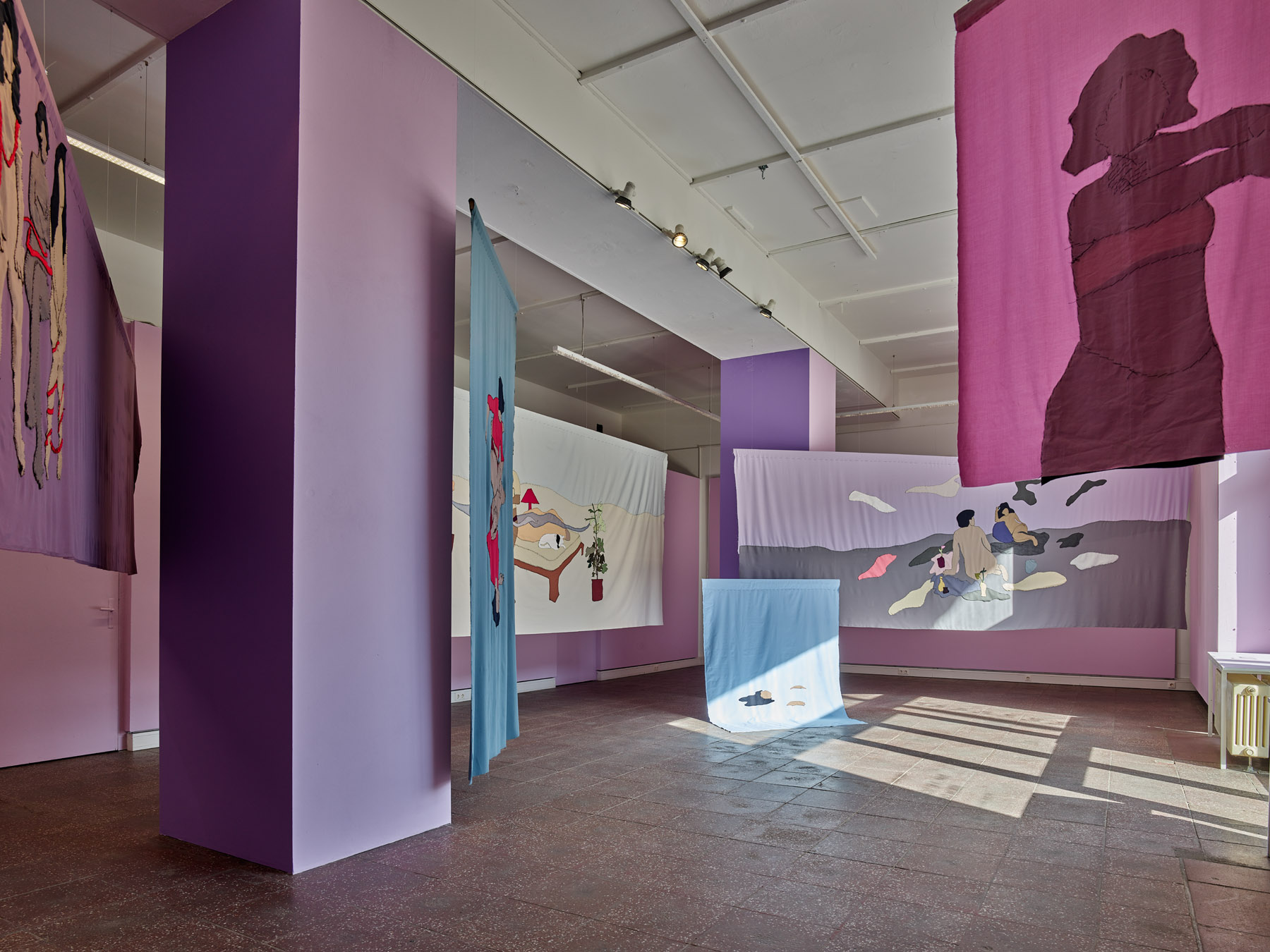

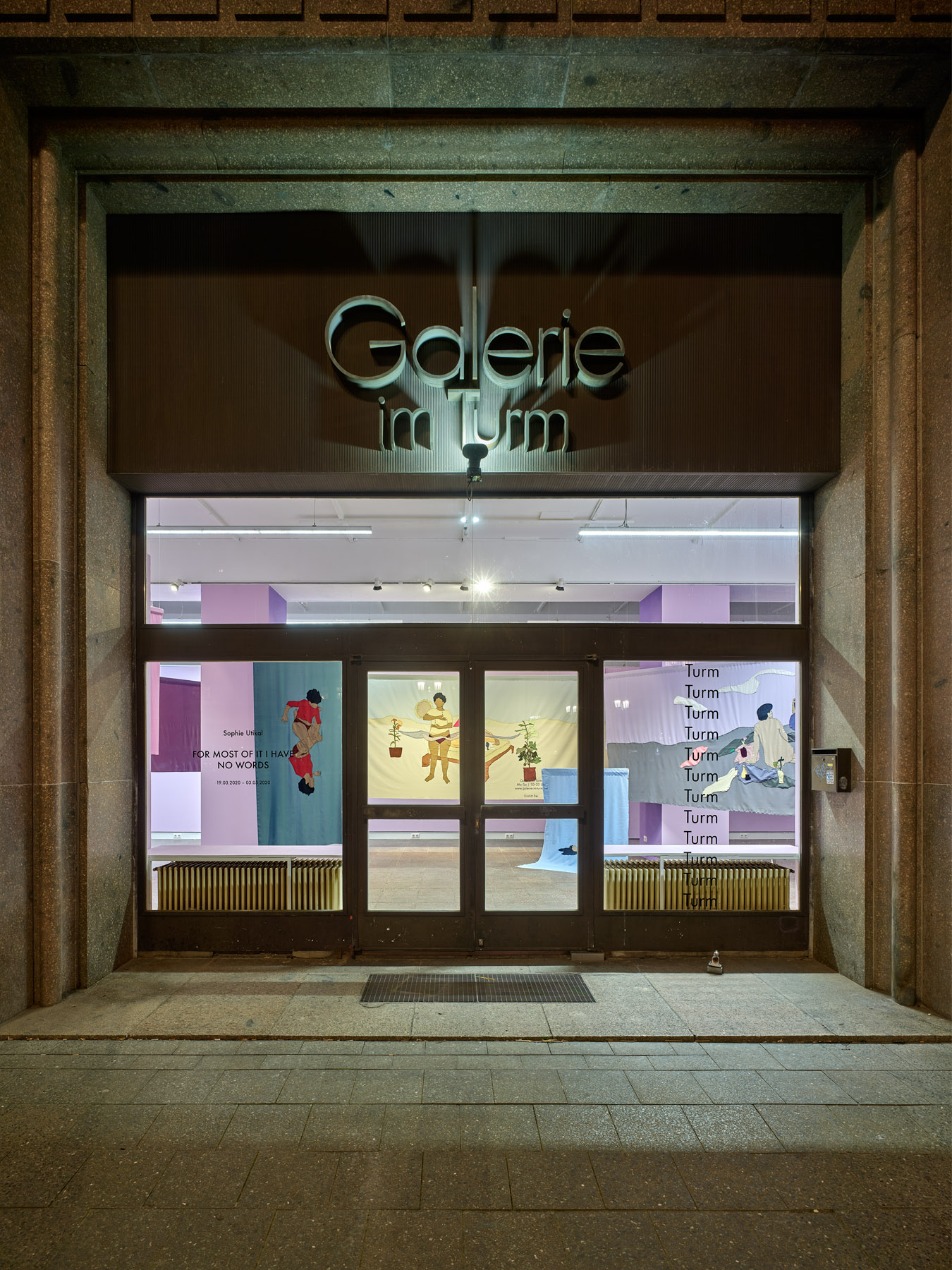
BURLUNGIS
COVEN BERLIN mit Yoav Admoni, Irene Fernández Arcas, Samantha Bohatsch, Hang Linton+Laura Lulika
23.01.2020 – 08.03.2020
